Evaluating the structure of economic provisioning systems has been a long-standing research issue in anthropological archaeology (Childe Reference Childe1936; Cobean Reference Cobean2002; Glascock et al. Reference Glascock, Michael Elam, Cobean, Farquhar, Hancock and Pavlish1988; Golitko and Feinman Reference Golitko and Feinman2015; Hirth et al. Reference Hirth, Andrews, Flenniken and Hirth2006; Hirth et al. Reference Hirth, Cyphers, Cobean, De León and Glascock2013; Rathje Reference Rathje, Sabloff and Lamborg-Karlovsky1975; Sanders Reference Sanders and Willey1956; Sanders and Santley Reference Sanders, Santley, Vogt and Leventhal1983; Sanders et al. Reference Sanders, Parsons and Santley1979; Spence Reference Spence1996; Spence et al. Reference Spence, Kimberlin, Harbottle, Ericson and Purdy1984). This research is challenging because provisioning systems of ancient complex societies typically involved multiple interdependent actors from multiple sites (Torrence Reference Torrence1986), and they often exhibited unique qualities as a result of local, cultural-historical processes (Brumfiel Reference Brumfiel1980, Reference Brumfiel, Brumfiel and Earle1987). All provisioning systems have four basic components: acquisition, production, distribution, and consumption (Costin Reference Costin and Schiffer1991). Archaeologically, it is possible to evaluate acquisition, production, and consumption directly based on the material remains they leave behind. Distribution, or the actual exchange of goods and services, however, is behavioral and therefore invisible (Costin Reference Costin and Schiffer1991). As a result, it must be inferred based on the quantity and quality of the artifacts associated with the other components. Flaked stone artifacts are especially useful for studying economic provisioning systems because they leave behind clear evidence of stone tool acquisition, production, and consumption.
This article presents the technological analysis of flaked stone artifacts from the Postclassic central Mexican city of Calixtlahuaca, located in the modern-day Toluca Valley (Figure 1). We address the following issues: (1) how different household technologies varied over time; (2) the nature of lithic tool production and consumption in the city, especially the all-important prismatic blade; and (3) what these data imply about the nature of the commercial networks that supplied the city with its stone tools. Our results are framed within a broader discussion of the organization of lithic craft production in Postclassic central Mexico and may also be applicable to the organization of other crafts.
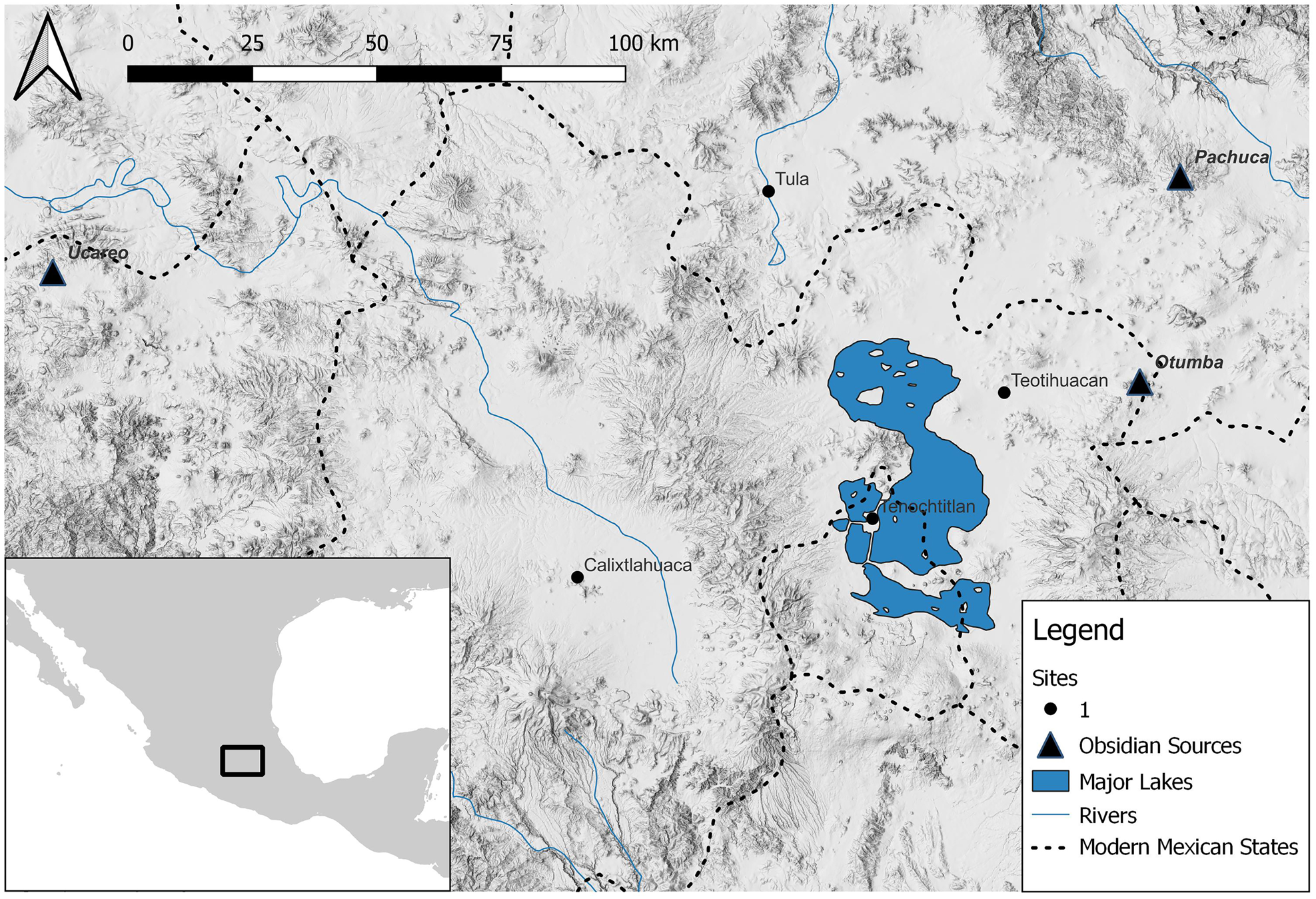
Figure 1. The location of Calixtlahuaca in Central Mexico and the sources of obsidian well represented in the city. Map by A. Huster.
Calixtlahuaca developed around a.d. 1130, during the Middle Postclassic, and was later conquered by the Aztec Triple Alliance (Berdan et al. Reference Berdan, Blanton, Boone, Hodge, Smith and Umberger1996:269; Borejsza et al. Reference Borejsza, Rodríguez, Fredrick and Smith2021; Garcia Castro Reference García Castro1999; Smith et al. Reference Smith, Borejsza, Huster, Frederick, López and Heather-Smith2013). Consequently, it provides a perspective of pre-Hispanic city life both before and after this event. The flaked stone tool data discussed here were recovered from domestic and secondary terrace deposits during the Calixtlahuaca Archeological Project, directed by the third author (Michael Smith) in 2006 and 2007 (Smith et al. Reference Smith, Borejsza, Huster, Frederick, López and Heather-Smith2013). The artifacts were classified by the first author (Bradford Andrews) using the analytical perspective of experimental lithic technology (Collins Reference Collins and Swanson1975; Crabtree Reference Crabtree1968; Flenniken Reference Flenniken1981; Hirth et al. Reference Hirth, Andrews, Flenniken and Hirth2003; Hirth et al. Reference Hirth, Bondar, Glascock, Vonarx, Daubenspeck and Hirth2006), which identifies how tools were made, and how patterns of tool production and consumption can be used to infer broader socioeconomic processes (Hirth and Andrews Reference Hirth, Andrews, Hirth and Andrews2002).
Although prismatic blade artifacts were important to the city's inhabitants, we found no credible evidence for blade-core workshops at Calixtlahuaca. There is, however, evidence for biface and uniface flaking, and the bipolar processing of various artifacts, presumably to maximize their use lives. The lack of evidence for blade crafting workshops was unexpected because such contexts have been identified at a number of other Highland Mesoamerican urban centers, including Teotihuacan, Xochicalco, Tula, Tzintzuntzan, and Otumba (Healan Reference Healan and Isaac1986; Hirth Reference Hirth2006c; Parry Reference Parry2001; Pollard et al. Reference Pollard, Glascock and Rizo1999; Spence Reference Spence1981). Archaeologists often intuitively associate craft production with dense urban settlements (although invariably, overall production processes involved intra- and interregional divisions of labor), whereas food production is more often associated with rural, hinterland communities (Borejsza et al. Reference Borejsza, Rodríguez, Fredrick and Smith2021:247). Calixtlahuaca appears to reflect the opposite, with an urban specialization in agricultural production at the expense of any significant investment in craft production (Borejsza et al. Reference Borejsza, Rodríguez, Fredrick and Smith2021; Huster Reference Huster2016). Our study supports this conclusion and considers the implications of what our technological analysis indicates about Aztec-period stone tool provisioning.
If workshops were absent at Calixtlahuaca, then how did blades get to its household consumers? To address this question, we discuss four blade provisioning models: (1) whole-blade trade, (2) processed-blade trade, (3) long-distance itinerant craftsmen, and (4) local, hinterland-based craftsmen. These models are evaluated by examining the proportions of two artifact categories associated with blade-core production contexts, and the specific ratios of proximal, medial, and distal prismatic blade sections (De León et al. Reference De León, Hirth and Carballo2009).
The following discussion is divided into five sections. First, we discuss the current theoretical approach for understanding Mesoamerican urbanism and its relationship to craft production. Second, we describe the archaeological context of the materials recovered by the Calixtlahuaca Project. Next, we examine the overall flaked stone tool collection and its technological characteristics. Fourth, in light previous research on Postclassic stone tool economies, we discuss the implications of our analysis, referencing specifically the artifacts contained in the individual household assemblages. This section includes a discussion of the meager evidence for prismatic blade production in the city. Finally, we consider the four blade-provisioning models, positing a market-based distribution of prismatic blades and other flaked stone tools.
Mesoamerican craft production and urbanism
Largely influenced by a Western European model of urbanism, many archaeologists associate the emergence of urban centers with the development of resident craft production. Ethnohistoric data from the Human Area Relations Files (HRAF) does show that, in general, the number and diversity of craft specialists in a society tends to correlate with settlement size (Clark and Parry Reference Clark, Parry and Isaac1991:309). However, research has also suggested that the functional organization of a particular city relates to the sociocultural environment within which it is embedded (Fox Reference Fox1977). Inspired by this insight, Sanders and Webster (Reference Sanders and Webster1988) argued that the energetic limitations placed on Mesoamerican societies by their reliance on human transport created conditions for the emergence of some relatively large urban centers (e.g., Teotihuacan) with producers of both food and crafts. Some urban centers, however, had a relatively high percentage of resident agricultural specialists, although the production of many specialized crafts had limited economies of scale, leading to their widespread distribution across the countryside as part-time producers (Sanders and Webster Reference Sanders and Webster1988).
Although not all the points raised in this seminal article have stood the test of time, these two have been well supported by Aztec research efforts. Evidence for agriculture immediately adjacent to, or even within, Aztec cities is widespread (Brumfiel Reference Brumfiel1980; Morehart Reference Morehart2016), and specialized production of a wide range of utilitarian goods has been found at smaller, “rural” sites—including textiles (Huster Reference Huster2019; Smith and Hirth Reference Smith and Hirth1988), maguey products (Evans Reference Evans and Blanton2005), and salt (Millhauser Reference Millhauser2012). The broader patterning of agricultural intensification and rural craft production indicates that the former occurred in areas of high agricultural productivity, whereas the latter was preferred in more agriculturally marginal areas (Fargher Reference Fargher2009). However, although studies of Aztec craft production and urbanism commonly note that there was a wide range in the intensity and diversity of crafting activities at Aztec cities—ranging from an intensive specialization in multiple classes of goods at Otumba to the near absence of evidence for production at Xico or Huexotla—there has been little consideration of the reasons for these differences (Smith Reference Smith2008). This article attempts to address this issue by examining the factors that could have allowed for the absence of local stone tool production in an urban setting.
Archaeological context of the materials
Calixtlahuaca was a moderate-sized urban center with a population of around 8,500 people on the slopes of Cerro Tenismo, located in the middle of the valley of Toluca, Mexico. The Toluca Valley is immediately west of the Basin of Mexico and forms the headwaters of the Lerma River. It is higher in elevation than the Basin of Mexico, resulting in a cooler and wetter climate. During the Postclassic, it was primarily occupied by Otomanguean (Matlazinca–Mazahua–Otomi) speakers (García Castro Reference García Castro1999).
Based on ceramic seriation, the site's occupation is divided into three phases: the Dongu (Middle Postclassic, a.d. 1130–1380), the Ninupi (Late Postclassic A, a.d. 1380–1450), and the Yata phases (Late Postclassic B, a.d. 1450–1530) (Huster and Smith Reference Huster and Smith2015). Accordingly, Dongu roughly corresponds to the Aztec I and II phases, whereas Ninupi and Yata correspond to the early and late Aztec III periods, respectively (Huster and Smith Reference Huster and Smith2015:Figure 8; Minc Reference Minc, Nichols and Rodríguez-Alegría2017). Calixtlahuaca dominated the Toluca Valley until it was conquered by the Triple Alliance around 1476. Although the end of the Yata phase is after the Spanish conquest, within two decades, most of the people of Calixtlahuaca had been forcibly moved to Toluca to provide labor for the building of churches and additional Colonial-period infrastructure. At its maximum extent, the city covered about 264 ha, consisting of pockets of monumental architecture scattered among domestic households (Novic Reference Novic2015) and a complex system of terracing (Borejsza et al. Reference Borejsza, Rodríguez, Fredrick and Smith2021). Earlier archaeological work in the 1930s principally focused on monumental architecture, including its somewhat unique circular pyramid and the royal palace (García Payón et al. Reference García Payón, de Magrelli, Castañeda, de Magrelli and Castañeda1979).
The Calixtlahuaca Project began in 2006, with an intensive surface survey of the city (Smith et al. Reference Smith, Borejsza, Huster, Frederick, López and Heather-Smith2013). In addition to defining the spatial extent of residential occupation, the survey conducted systematic surface collections of artifacts that were subsequently classified and quantified. These data provided the basis for selecting areas to be excavated in 2007. The excavations focused on house remains and associated terrace deposits to establish the city's chronology and define its urban morphology (Smith et al. Reference Smith, Novic, Huster and Kroefges2009; Smith et al. Reference Smith, Borejsza, Huster, Frederick, López and Heather-Smith2013:227). Of the 27 excavation areas, nearly half focused on house remains (Figure 2), whereas the rest predominantly uncovered deposits related to the construction and decay of residential and agricultural terraces and associated water management features (Borejsza et al. Reference Borejsza, Rodríguez, Fredrick and Smith2021). Households typically consisted of one or two adobe or wattle-and-daub rooms, in addition to stone-paved intermural activity areas. The household-focused excavations provided a core domestic sample of six components (a component is a single phase from one house) representing each of the city's three phases, resulting in a total of 18 household components. The associated terrace and water management excavations were conducted to explore how these features were deployed over the slopes of Cerro Tenismo (Borejsza et al. Reference Borejsza, Rodríguez, Fredrick and Smith2021; Smith et al. Reference Smith, Borejsza, Huster, Frederick, López and Heather-Smith2013). The artifacts recovered by the Calixtlahuaca Project were divided into five nested domestic samples (DS-1, DS-2, DS-3, DS-4, And DS-5) according to how securely their contextual associations were and the degree of analysis that they received. The analysis of the types of lithic artifacts from the individual household components were only based on the DS-1 and DS-2 samples. The most securely dated artifacts are in the DS-1 sample, which came from excavation lots that could be confidently assigned to a single phase in clear association with household architecture, midden deposits, and other deposits with little to no evidence of redeposition (Huster Reference Huster2016). The DS-2 sample includes securely dated lots that were peripherally or well-associated with household components. The extensive, well-dated sample of excavated contexts allows us to conduct a robust intrasite analysis of provisioning over time—something that is relatively rare in obsidian studies (Ossa Reference Ossa2022). For the purposes of this discussion, the “Calixtlahuaca collection” refers to all the artifacts analyzed, whereas the term “assemblage” refers to artifact collections representing temporally distinct household components dating to one of the three phases of occupation.
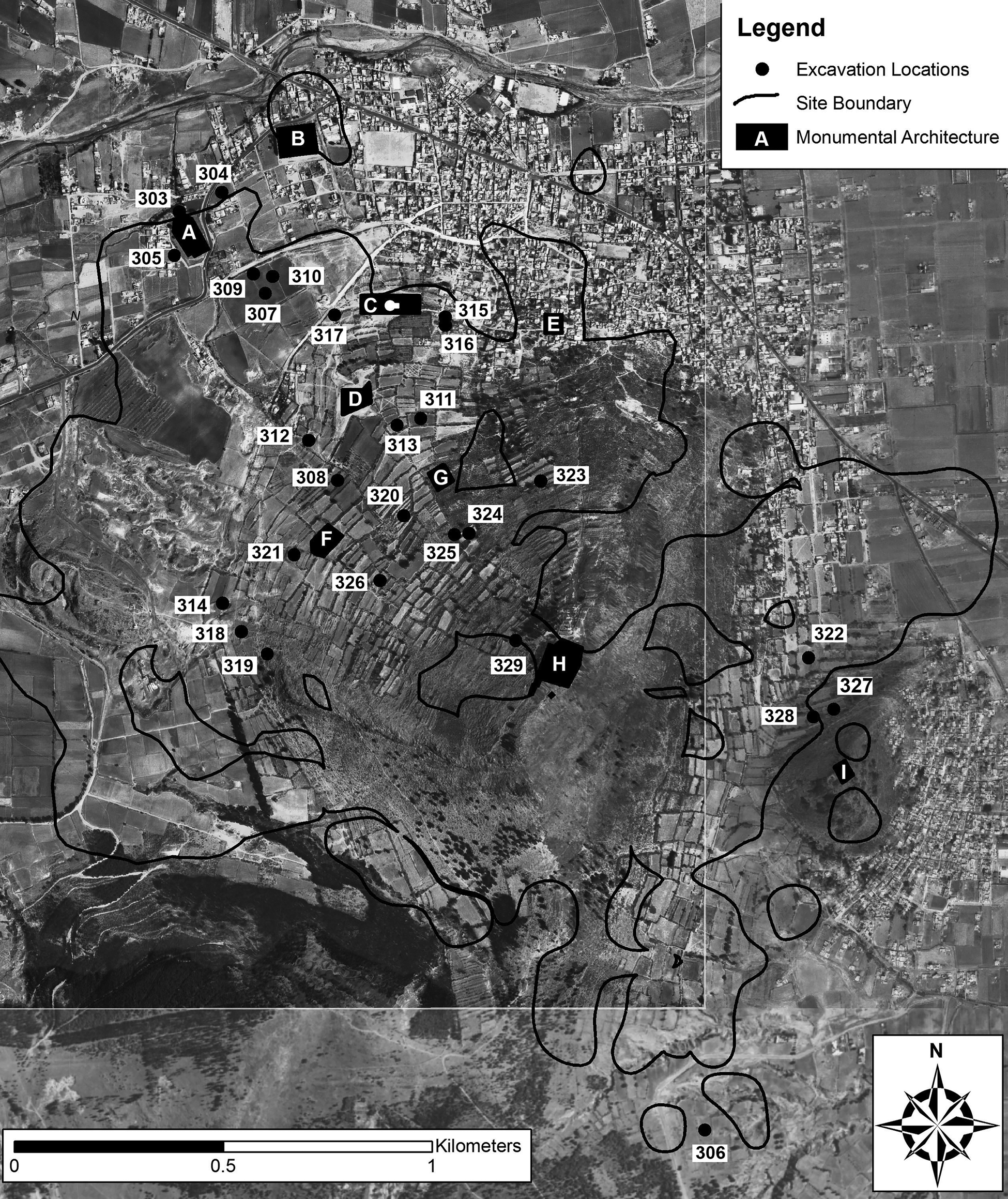
Figure 2. Map of Calixtlahuaca showing the site boundary and the location of the excavation units. Map by A. Huster.
The flaked stone collection
The Calixtlahuaca Archeological Project recovered 19,163 flaked stone artifacts. This study is based on the analysis of a sample of 10,095 (53%) of these artifacts (Table 1). It was selected based on two criteria. First, priority was given to excavation lots that could be securely phased and attributed to a particular household with a reasonable degree of confidence. This strategy maximized the number of artifacts from domestic lots for evaluating trends over time. Second, a number of additional lots that did not meet these criteria but provided relatively large samples of artifacts were also analyzed to help provide a more comprehensive technological impression of the types of flaked stone tools consumed in the city. Time constraints precluded the analysis of the entire collection. Although several material types are represented (Table 1), most of the collection consists of gray (75%) and green obsidian (19%). Overall, obsidian comprises 94% of the collection. The remaining 6% is composed of basalt, andesite, chert, quartz, quartzite, and slate artifacts.
Table 1. Material types represented in the analyzed Calixtlahuaca collections.
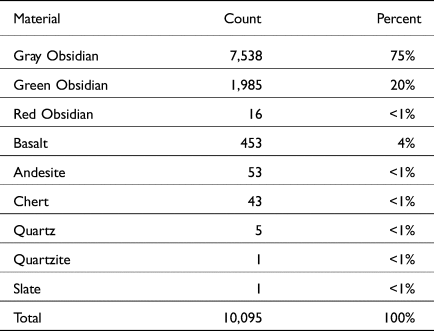
Obsidian sources represented in the collection
Obsidian sources represented at Calixtlahuaca include Ucareo/Zinapecuaro, Pachuca, and Otumba (Table 2), in addition to several other minor sources (Burke and Gauthier Reference Burke and Gauthier2013; Glascock Reference Glascock2014; Huster Reference Huster2016:Tables 4.10 and 4.11). The Burke and Gauthier (Reference Burke and Gauthier2013) analysis did not distinguish the Ucareo from Zinapecuaro obsidian sources. However, Glascock (Reference Glascock2014) did source confirmation using INAA on some of the XRF artifacts he analyzed; out of the 38 artifacts in this INAA analysis, 32% (N = 12) were sourced to Ucareo and 5% (N = 2) were sourced to Zinapecuaro. This small sample suggests most of the obsidian representing these sources at Calixtlahuaca is probably from Ucareo. The discussion of source frequency is based on the XRF analysis of 151 gray obsidian samples, paired with the visual identification of green obsidian. It is noteworthy that obsidian from Ucareo in west Mexico was always well represented at Calixtlahuaca; it was most prevalent during the Dongu phase, but it declined by the Yata phase (Figure 3). The observed changes in the relative source frequencies over time could be explained by either an increase in central Mexican sources or a reduction in west Mexican sources. When the frequency of obsidian by source is calibrated as pieces of obsidian from a given source per 1,000 sherds, all sources show an increase in absolute frequency between the Dongu and Ninupi phases, followed by a reduction in access during the Yata phase, with the shifting source frequency resulting primarily from less of a decline in access to central Mexican sources (Figure 3).
Table 2. Major obsidian sources represented in the Calixtlahuaca obsidian flaked stone artifact collection (from Huster Reference Huster2016:Table 4.10).

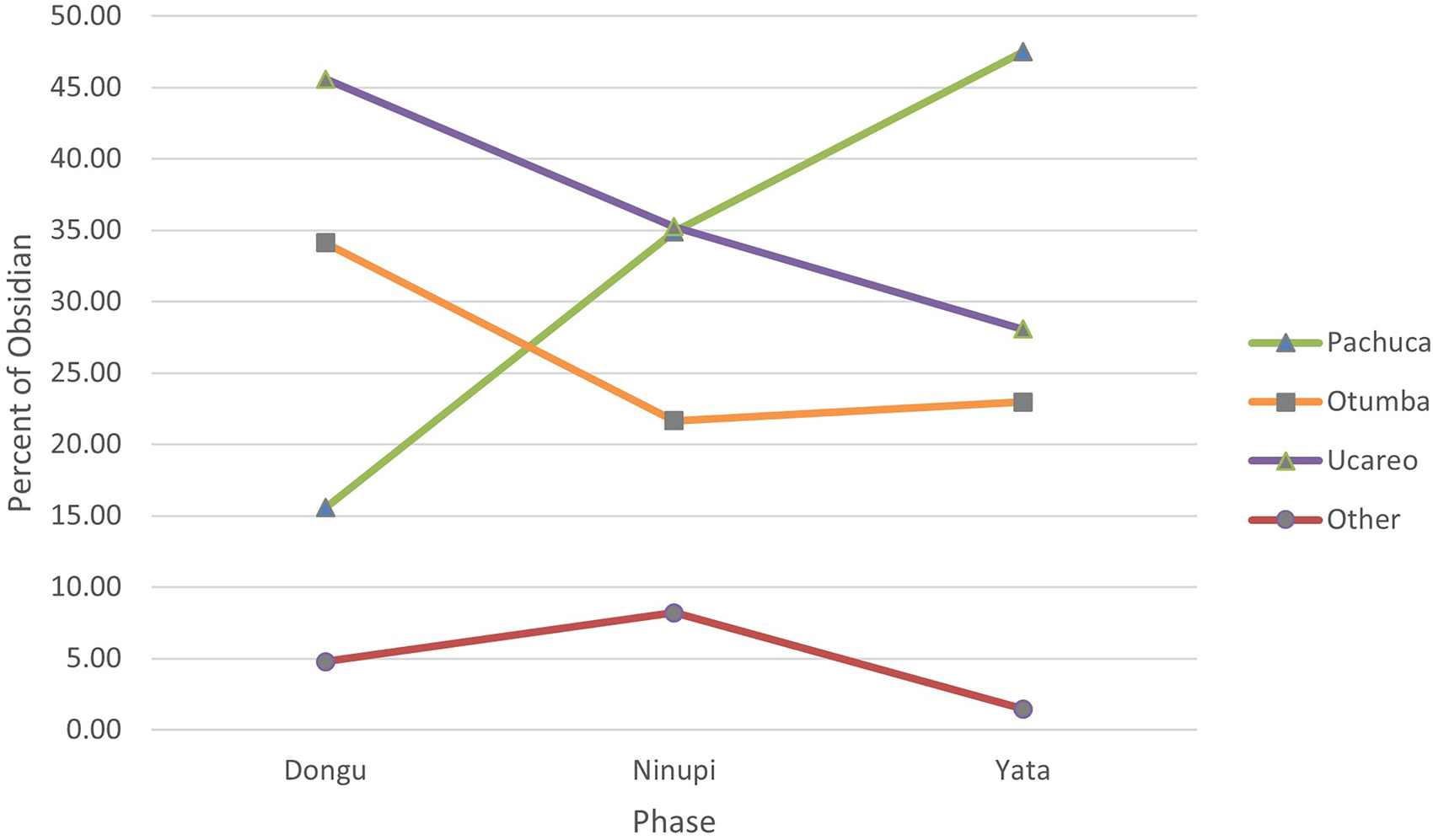
Figure 3. Obsidian sources represented in the Calixtlahuaca collection over time.
The prevalence of Ucareo obsidian is one reason the Calixtlahuaca collection was always dominated by gray obsidian. However, the balance of Pachuca and Otumba suggests that for all three phases, (1) the collection was primarily composed of material from central Mexican sources, and (2) the frequency of Pachuca and Otumba obsidian increased over time, being the most prevalent in the Yata phase.
Both the obsidian and nonlocal ceramics at the site show their most diverse assemblages—and presumably the widest range of interregional trade ties—during the Ninupi phase (Huster Reference Huster2016:176), which coincides with the Late Postclassic, a period of intensification of the central Mexican Mesoamerican World System (Smith Reference Smith, Susan E., D'Altroy, Morrison and Sinopoli2001). It is during this phase that the number of obsidian sources in the city's assemblages reached their greatest diversity. This finding highlights rather clearly that Calixtlahuaca was significantly tied to obsidian exchange networks from both the Basin and west Mexico. With the transition to the Yata phase, which began a decade prior to the conquest of Calixtlahuaca by the Triple Alliance, the city's interregional commercial activity began to decline. This decline may have been related to the changing sociopolitical situation in the Basin, perhaps the Tepanec hegemonic pressure over the Toluca Valley that began around a.d. 1370 (Tomaszewski and Smith Reference Tomaszewski and Smith2011).
Technological Characteristics of the Lithic Artifacts
The technologically diagnostic artifacts include blade-core, biface, bipolar, and expedient flake core artifacts, making up 63% of the collection (Table 3). Most of the technologically diagnostic artifacts are blade-core (67%) and biface (21%) material, but bipolar artifacts are a significant minority (11%). It is no surprise that blade-core technology dominates the collection, because, with few exceptions, the prismatic blade was the standard cutting, scraping, and piercing implement throughout pre-Hispanic Mesoamerica (Clark Reference Clark, Gaxiola G. and Clark1989:311; Hirth Reference Hirth and Hirth2006b:3; Reference Hirth2008:436). Besides technological classification, each artifact was also visually examined for systematic patterned chipping, striations, and polish consistent with use-wear attributes (Andrews and Hirth Reference Andrews, Hirth and Hirth2006; Hirth and Costanzo Reference Hirth, Costanzo and Hirth2006a). Most of the blade-core artifacts show use wear (66%); the figures for bipolar (46%) and biface (19%) artifacts are lower (Table 4). Overall, 55% of the technologically diagnostic artifacts were clearly used. This analysis examined artifacts with a 10x hand lens—a higher–magnification study would probably elevate the percentages of used tools considerably. Even so, these use-wear percentages indicate that the residents of Calixtlahuaca were predominantly stone tool consumers.
Table 3. Technologically diagnostic obsidian artifacts (63% of the entire assemblage).
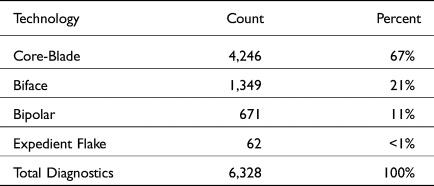
Table 4. Technologically diagnostic obsidian artifacts and percent used (55% of the diagnostic assemblage).
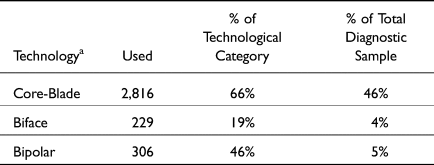
a Use-wear analyses of the non-obsidian artifacts were not conducted. These items were a minor component of the collection and most of these materials were not amenable to use-wear analysis with a 10x hand lens.
Most of the blade-core artifacts were pressure blades (Table 5; Figure 4a–c). Pressure blade fragments include proximal, medial, and distal sections consistent with the pan-Mesoamerican practice of snapping blades into smaller pieces to use with or without further modification. Moreover, the majority of proximal blade sections (93%, N = 562) had ground platforms consistent with the standard Postclassic platform treatment throughout Mesoamerica (Healan Reference Healan2009); the rest were single facet (N = 40) and cortical (N = 1) platforms. Modified pressure blade sections included projectile points, eccentrics, notched blades, and pointed-tipped blades (Figure 4d–l). The remaining few blade-core artifacts are core fragments, core section flakes, platform preparation flakes, and miscellaneous core platform rejuvenation flakes. The presence of these artifacts is typically considered evidence for on-site blade production, but we argue below that their frequencies do not support this inference. Surprisingly, the collection contained no large, percussion-blade keyhole scrapers for processing maguey like those found elsewhere in central Mexico (Parsons and Darling Reference Parsons and Darling2000). In part, this may be explained by the presence of tabular basalt scrapers at Calixtlahuaca that appear to have been used to process maguey (Huster Reference Huster2019).
Table 5. Obsidian technological artifact categories in the Calixtlahuaca collection.
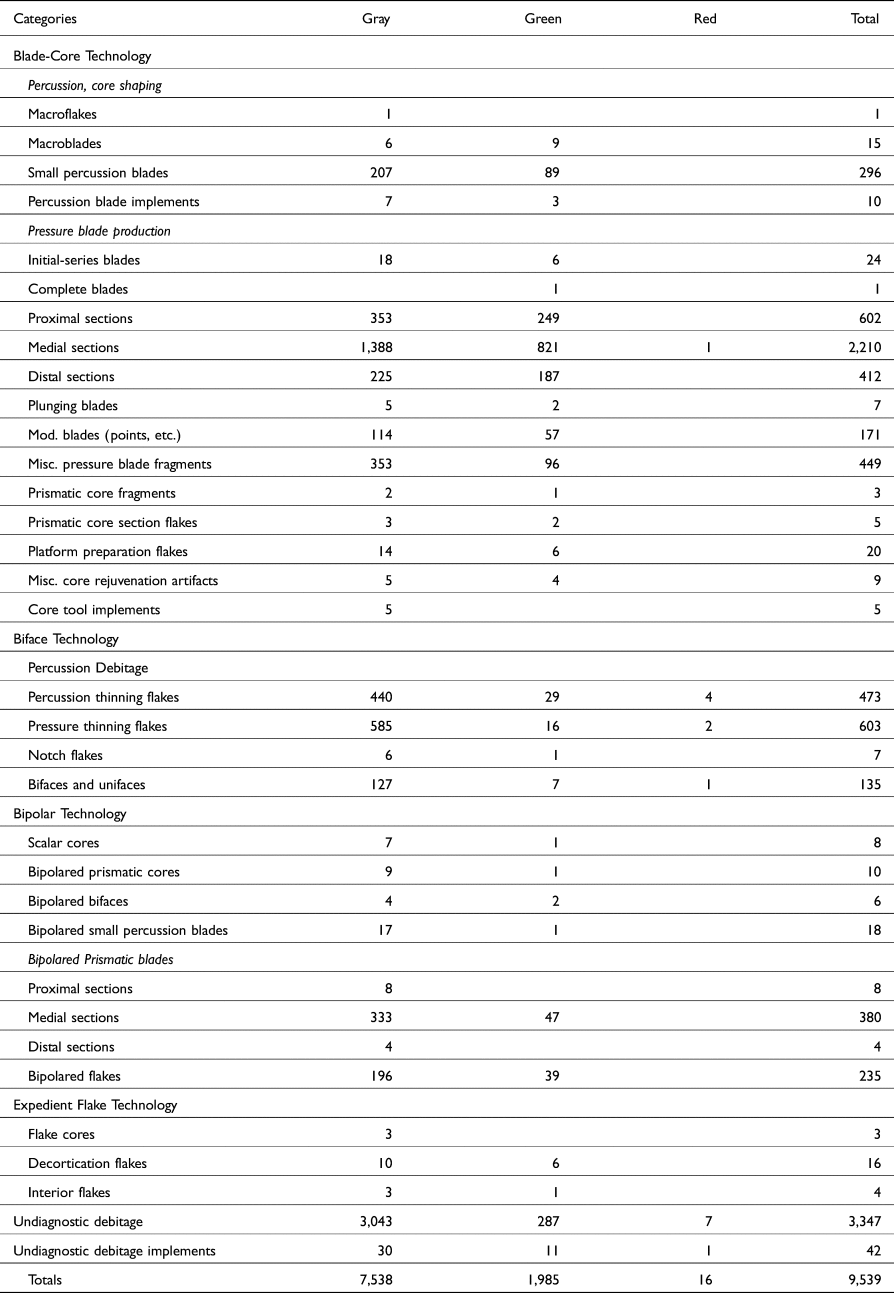

Figure 4. Obsidian blade-core artifacts recovered from Calixtlahuaca: (a) small, heavily used percussion blade section (gray); (b) complete triangular pressure blade (gray); (c) complete third-series pressure blade (gray); (d) pointed tipped pressure blade section (gray); (e) notched “hafted” pressure blade section (gray); (f) small convex base projectile point (green); (g) crescent eccentric (green); (h–i) large side-notched, convex base projectile points (green); (j–k) small basal-notched projectile points (gray); (l) small basal notched projectile made out of a distal blade section (gray). Illustrations by B. Andrews and K. Godfrey.
The biface material consisted of biface and uniface artifacts and the percussion and pressure-thinning flakes representing their production (Table 5, Figures 5, 6). The presence of a considerable number of percussion biface-thinning flakes indicates that at least some flake blanks and/or biface and uniface preforms were imported and further reduced in the city's households. The pressure bifacial-thinning flakes indicate that they were further shaped and resharpened. A few notch flakes (Figure 6k) were also identified, indicating that some bifaces were hafted (Figure 5b).
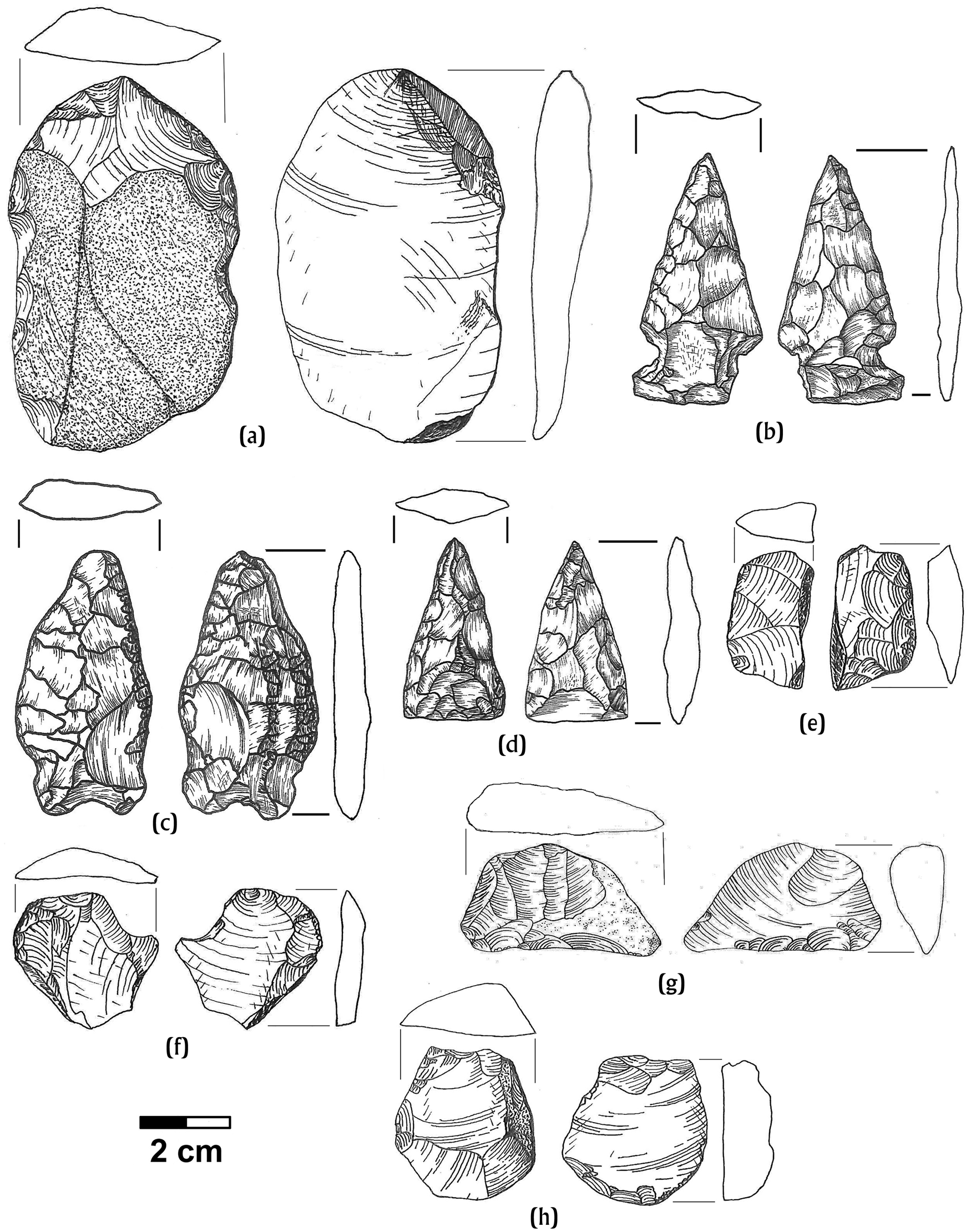
Figure 5. Obsidian biface and uniface artifacts recovered from Calixtlahuaca: (a) flake blank unifacial scraper (green); (b–c) side and basal-notched bifaces (gray); (d) straight-base projectile point “preform” (gray); (e–f) bifacial scrapers (e, gray; f, green); (g) bifacial side scraper made from cortex-bearing bifacial edging flake (gray); (h) unifacial scraper (gray). Illustrations by B Andrews, K. Godfrey, and K. Hunt.
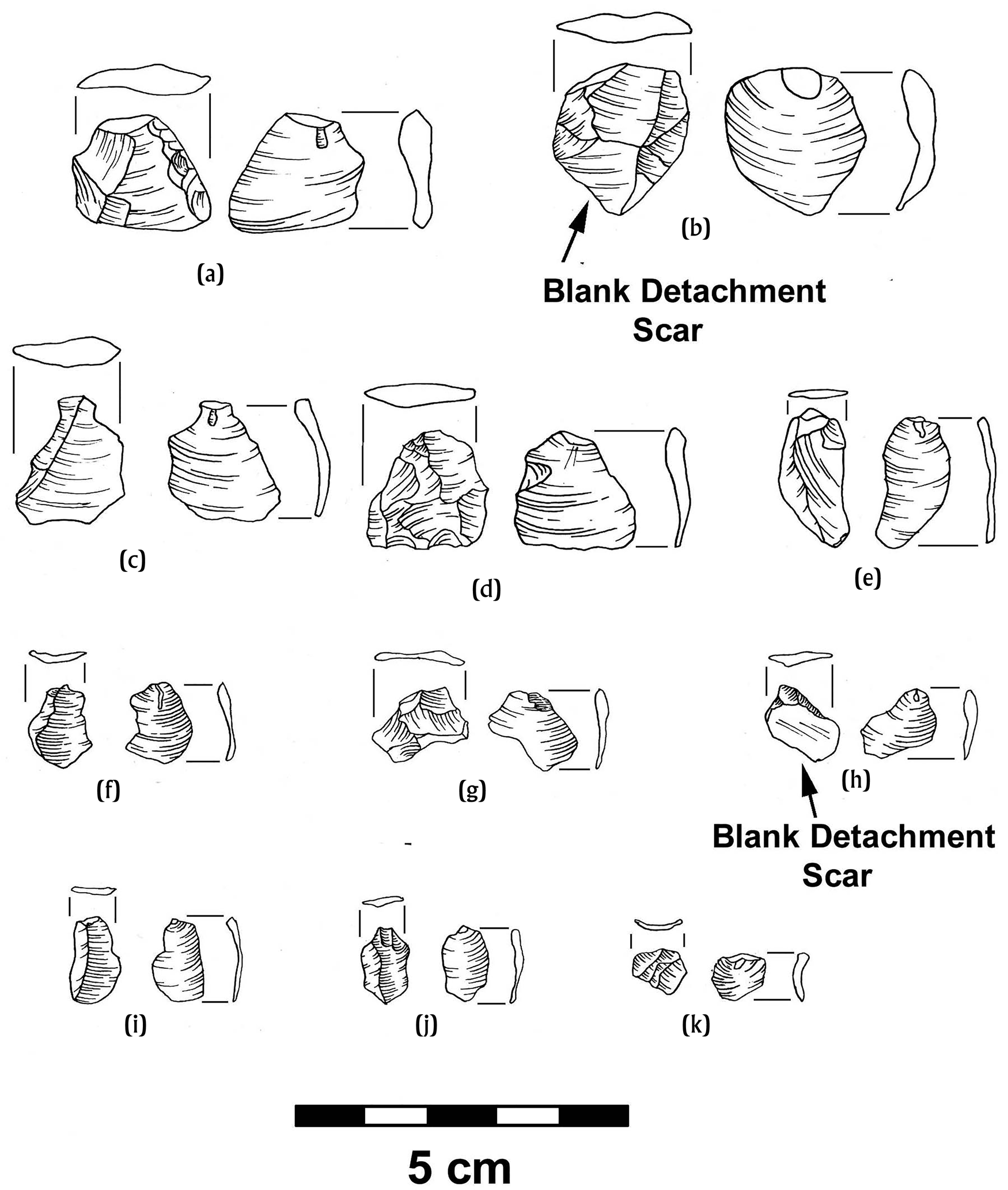
Figure 6. Percussion and pressure biface thinning flakes recovered from Calixtlahuaca households: (a) early percussion biface thinning; (b–d) late percussion biface thinning; (e–h) early pressure biface thinning; (i–j) late pressure biface thinning; (k) notch flake. Illustrations by K. Hunt.
The bipolar material consisted of a few scalar cores (Figure 7k–l), bipolared pressure cores, bifaces (Figure 7j), and small percussion blades (Table 5; Figure 7g–h). Scalar cores are wedge-shaped tablets that may have been used for woodworking (Hayden Reference Hayden1980). Surprisingly, there were also a number of prismatic blade sections that appear to have been set one end down on an anvil and hit with a hammer, producing longitudinally fractured sections with sharp edges (Andrews Reference Andrews and Selin2015) (Figure 7a–f). Although not as ubiquitous, the same blade section treatment has been reported for Postclassic Cihuatecpan (Walton Reference Walton2017) and Xaltocan (Millhauser Reference Millhauser and Brumfiel2005); indeed, this practice probably has great time depth, having been reported in Formative contexts from Oaxaca (Parry Reference Parry1987:57, 61, items referred to as “scaled blades”). The balance of the bipolar material is a miscellany of bipolar flakes. The remaining obsidian artifacts in the Calixtlahuaca collection consist of a few flake cores, decortication flakes, and interior flakes; these items were primarily produced to make expedient flakes for various uses.
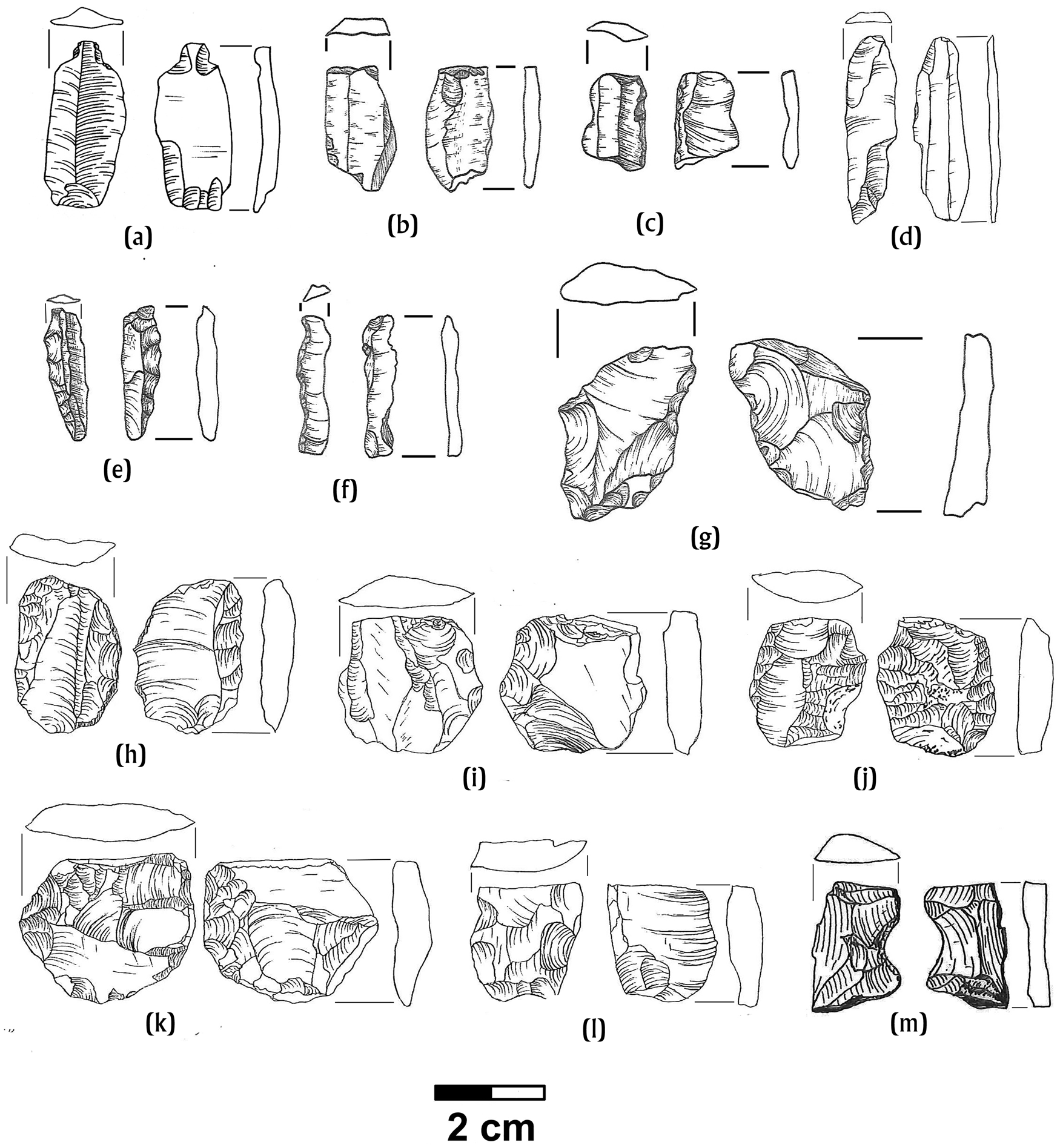
Figure 7. Bipolar artifacts recovered from Calixtlahuaca: (a, green; b–f, gray) bipolared medial blade sections; (g–h, gray) bipolared small percussion blade medial sections; (i, gray) bipolared macroblade section; (j, gray) bipolared biface mid-section; (k–l, gray) scaler bipolar cores; (m, gray) bipolar notched flake scraper. Illustrations by K. Godfrey, H. Bolz-Weber, and B. Andrews.
The nonobsidian artifacts are a minor component of the stone tools consumed in the city (Table 6). Most of them were made of basalt, including bifacial and unifacial implements, many of which were probably used as scrapers for processing maguey (Huster Reference Huster2019). Some of the basalt flakes were probably removed to make these scrapers. Evidence for the use of basalt for scraping maguey has been found at numerous pre-Columbian central Mexican sites (Parsons and Parsons Reference Parsons and Parsons1990). What is most curious about the Calixtlahuaca collection, however, is the essential absence of “keyhole” maguey scrapers, the common tool type used to process maguey in Postclassic central Mexico (Evans Reference Evans1990). Nevertheless, recent use-wear analysis of artifacts from Cihuatecpan, a Postclassic settlement focused on maguey cultivation, has revealed that many different scraper types were used to process the plant (Walton Reference Walton2017), so the absence of keyhole scrapers does not undermine the likelihood that maguey production was an important economic activity at Calixtlahuaca (Huster Reference Huster2019).
Table 6. Non-obsidian technological artifact categories in the Calixtlahuaca collection.
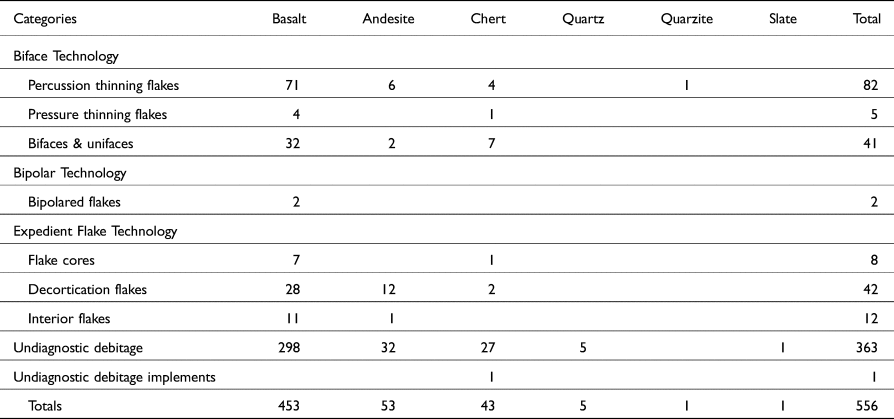
The remaining nonobsidian artifacts include a few biface and uniface implements, flakes removed during bifacial reduction, and flakes detached in an expedient manner, presumably for use without modification. The overwhelming majority of the nonobsidian artifacts are technologically undiagnostic. Given such a minor representation, the remaining discussion will focus on the obsidian artifacts.
Household technological trends over time
Throughout the site's occupation, almost all household components include technologically diagnostic evidence of blade-core, biface, and bipolar reduction, although the relative proportions of the three technologies vary (Table 7). Moreover, except for the Yata components, most households also have limited evidence of expedient flake core reduction. These figures indicate that the same basic household strategies were employed in the use and maintenance of flaked stone tools in the city. Results of Fisher Exact Tests indicate that only three assemblages appear distinct from their phase counterparts. Dongu household 307 differs in that it has very low percentages of blade production evidence, either primary or secondary (discussed below); Dongu household 323 and Ninupi household 316 differ in that they have comparatively high frequencies of secondary blade production evidence. We view these differences as minor.
Table 7. Obsidian lithic tool percentages and counts according to household components and technology over time (DS-1 and DS-2 domestic samples).

Blade-core technology was dominant in all components, which suggests, as was the case throughout most of Mesoamerica, that the prismatic blade was fundamental to the city's economy. Blade artifacts were the least prevalent in the Dongu phase, averaging 67% of the component assemblages (Table 7); the importance of blade tools increased over time, rising to an average of 83% by the Yata phase (Table 7). Proportionally, this increase in blade tools was largely associated with a corresponding decrease in bifacial tools and an increase in Pachuca obsidian, which was exceptional for making blades (Pastrana Reference Pastrana1998:87).
Biface technology was the second most prevalent technology. Once again, the frequency of biface thinning flakes in addition to formed tools suggests that some biface reduction took place in the city's households (Figure 8). Biface artifacts decreased markedly from a high of 25% in the Dongu phase to a low of 10% in the Yata phase. Among a number of possible reasons for this decrease were changes in the Postclassic sociopolitical landscape. The increasing prevalence of Pachuca over Ucareo (both primarily used for blades) is likely related to the city's conquest by the Triple Alliance during the Yata phase. After incorporation into the empire, it appears that the city became increasingly dependent on the commercial networks bringing products out of the Basin of Mexico. At the same time, conquest by the Triple Alliance appears to have constrained the effectiveness of the networks bringing Ucareo obsidian from west Mexico, some of which was used to make bifacial implements (but it was also used to make blades). Indeed, it seems that west Mexico was largely isolated in terms of obsidian exchange during the Postclassic (Golitko and Feinman Reference Golitko and Feinman2015). The decrease in biface material by the Yata phase might also indicate a decline in the availability of faunal resources in the Toluca Valley, thereby reducing the demand for projectile points. Indeed, research indicates that the dietary intake of hunted meat protein became largely restricted to the nobility in Aztec Mexico, suggesting a relative scarcity of these resources by the Postclassic period (Smith Reference Smith, Nichols and Rodríguez Alegría2016).
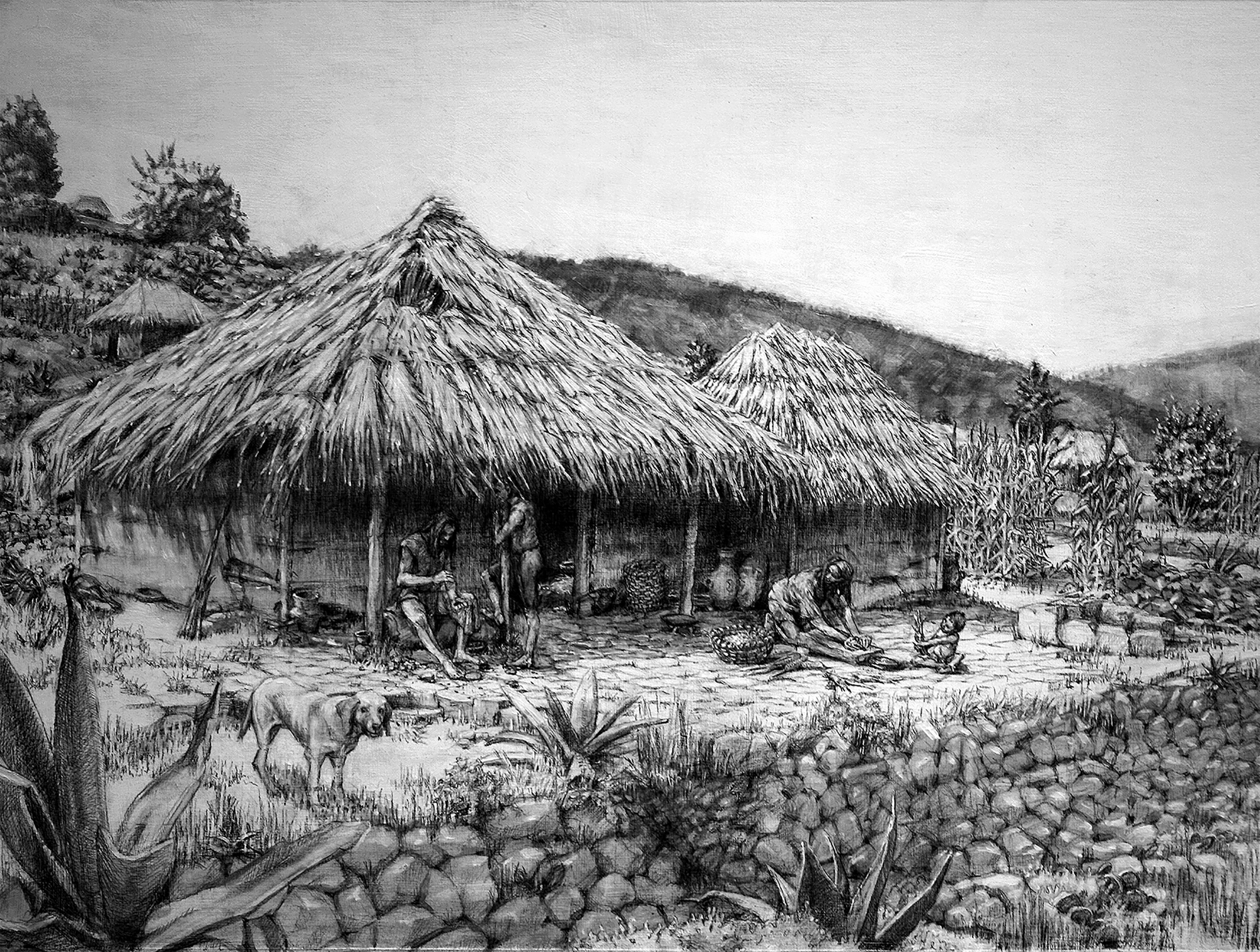
Figure 8. Artist's reconstruction of biface flaking at a Postclassic Calixtlahuacan household. Illustration by Michael Stasinos.
Except for expedient flake core reduction, bipolar technology was the least important. It was used to reduce both blade and biface artifacts in addition to other tools made from miscellaneous obsidian, chert, and basalt artifacts (Figure 7). The prevalence of evidence for bipolar reduction was lowest during the Ninupi phase (Table 7). The sourcing data indicate that during that phase, obsidian from numerous sources was available at Calixtlahuaca, resulting in less pressure to extend the use life of spent, or “exhausted,” blades and bifaces. It also provides a clear demonstration of what has been referred to as “production linkage relationships” (Hirth and Andrews Reference Hirth, Andrews, Hirth and Andrews2002). Such arrangements refer to reduction sequences that incorporate two or more lithic technologies, so that the “by-products” of one become tool blanks for another. Here, what we see is the recycling of blade and bifacial implements using bipolar technology, resulting in new tools or new tool edges.
The percentage of bipolar artifacts was the highest in the Yata phase, which might indicate that pressure to extend tool use life was highest during this period (Table 7). That makes sense because the overall frequency of obsidian in Calixtlahuca households was nearly 50% lower during the Yata phase than it was during the previous Ninupi phase (Table 8). However, the high frequency of bipolar artifacts during the Yata phase is largely attributable to household 324, in which they make up 27% of its assemblage (Table 7). Removing this outlier reduces the bipolar mean for the other five components to 2 (σ 1.8). Even so, if bipolar techniques were used to maximize tool use life, the exceptionally high percentage of bipolar artifacts in household 324 is consistent with the impression that it was relatively poor (Huster Reference Huster2016). It ranked low in terms of quantity of imported ceramics, and it lacked cotton spindle whorls, figurines, and ground stone. Whatever the case, it may well be that the drastic reduction in the quantity of obsidian in Calixtlahuaca households during the Yata phase simply meant there was less to process overall, regardless of technology.
Table 8. Obsidian household assemblage sizes/phase and obsidian quantities per 1,000 sherds.
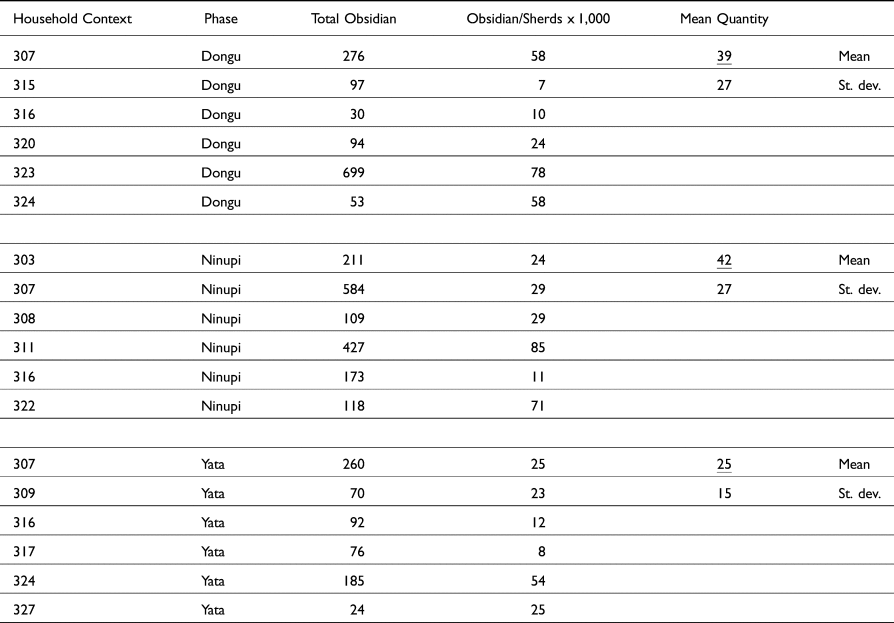
aFigures from Huster Reference Huster2016:Table 4.14, DS-1 sample only.
Discussion
These data indicate that Calixtlahuaca households engaged in limited biface/uniface reduction and the bipolar processing of both blade-core and biface artifacts; we maintain that this production was largely unspecialized but adequate for shaping and maintaining biface artifacts and recycling other flaked stone tools. The blade-core artifacts were clearly the most important during all phases (Tables 5 and 7), but we have concluded that these items were made elsewhere and imported into the site. As we discuss below, there is little evidence to suggest that prismatic blades were crafted in the city. Regarding the intensive survey of the city, as a result of the depositional history of terrace collapse and rebuilding at the site, it is unlikely that the heavy obsidian debitage concentrations produced by a typical workshop would have completely lacked a surface manifestation. Consequently, we are confident with this inference. Here, we first highlight examples of well-documented Mesoamerican blade-crafting contexts, then emphasize the research to date on the Postclassic. Subsequently, we examine how the data from the Calixtlahuaca household components compare to these earlier findings.
Stone tool craft production in the Postclassic
Many convincing examples of blade-crafting workshops/deposits have been found in Mesoamerican urban centers (Aoyama Reference Aoyama1999; Healan Reference Healan and de Arechavaleta1990; Spence Reference Spence, de Tapia and Rattray1987; Spence et al. Reference Spence, Kimberlin, Harbottle, Ericson and Purdy1984). Prior to the Postclassic, notable examples backed by rigorous technological analyses include the Classic-period workshop in the Tlajinga barrio of Teotihuacan (Hirth et al. Reference Hirth, Carballo, Dennison, Carr, Imfeld and Dyrdhal2019), an Early Classic workshop dump from the Mayan site of Ojo de Agua (Clark and Bryant Reference Clark and Bryant1997), and five Epiclassic workshops from Xochicalco (Hirth Reference Hirth2006c) (Table 9; the significance of its two far-right columns is discussed below). What is noteworthy about these examples is that they all have assemblages with over 11,000 artifacts. Moreover, they are all regarded as remains associated with part-time domestic workshops occupied by craftsmen who also engaged in other economic pursuits (e.g., agriculture). Nevertheless, from these examples, it is clear that flaked stone tool production on any specialized scale produces lots of debitage.
Table 9. Comparative characteristics of excavated specialized obsidian craft deposits with evidence for the production of prismatic blades.
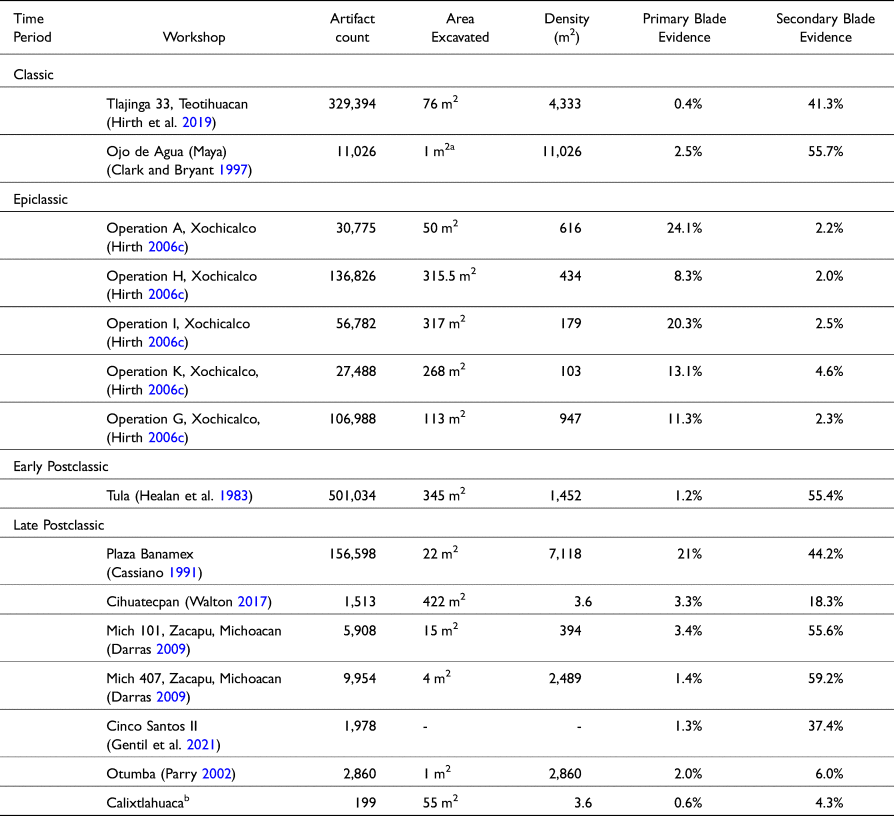
a The Ojo de Agua sample was found in a chultun (cistern) in the north corner of a 4 x 6 m excavation unit. The chultun has a footprint that is roughly 1 x 1 m in area.
b The Calixtlahuaca figures depicted here are averages of the 18 separate household assemblages examined by this analysis. They were derived by summing the percentages of primary and secondary artifacts presented in Table 11 for each excavated household and then dividing them by 18.
Relative to earlier periods in pre-Columbian Mesoamerica, research on Postclassic specialized lithic craft production has been more limited (Pastrana Reference Pastrana2007:111). Initial research efforts in the Basin of Mexico identified blade and biface workshops in both urban and rural settings for the altpehmeh of Otumba (Otis Charlton et al. Reference Otis Charlton, Charlton, Nichols, Santley and Hirth1993; Parry Reference Parry2001), Tepeapulco (Charlton Reference Charlton1978; Parry Reference Parry2001), Huexotla (Brumfiel Reference Brumfiel1980), Xico (Brumfiel Reference Brumfiel and Isaac1986), the Aztec-period occupations in and around the city of Teotihuacan (Spence Reference Spence and Folan1985), the site of Chiconautla in the northern part of Lake Texcoco (Elson Reference Elson1999; Parry Reference Parry2001:108) and Xaltocan (Brumfiel Reference Brumfiel and H. R.1991; Millhauser Reference Millhauser and Brumfiel2005). Except for the content of single 1 x 1 m household unit excavated at Otumba (Parry Reference Parry, Hirth and Andrews2002, discussed below), we view most of these examples as tentative because they are based on surface collections and a few test excavations that generated relatively small samples, the significance of which is difficult to interpret (Parry Reference Parry2001:106). Clark (Reference Clark and Isaac1986) cautioned years ago that surface manifestations do not necessarily reflect subsurface realities. Large-scale workshop excavations at sites such as Classic-period Teotihuacan (Hirth et al. Reference Hirth, Carballo, Dennison, Carr, Imfeld and Dyrdhal2019) indicate that sometimes they do, but this is not always the case (Hirth Reference Hirth1995; Reference Hirth and Hirth2006a:Table 2.1). It is surprising that this earlier research continues to be cited as support for the grand central Mexican economic narratives of the 1970s and 1980s (Sanders and Santley Reference Sanders, Santley, Vogt and Leventhal1983; Sanders et al. Reference Sanders, Parsons and Santley1979), but to date, there still have been few subsurface efforts to test them.
Several more convincing claims of specialized crafting contexts dating to the Postclassic are based on excavated deposits with relatively robust samples, predominantly from blade workshops (Table 9). One of the best examples is the work by Healan (Reference Healan and Isaac1986; Healan et al. Reference Healan, Kurley and Bey1983) at the Early Postclassic Toltec city of Tula. Here, a sizable domestic blade-crafting workshop on the periphery of the city indicates that Tula did have craft specialists who made blades out of obsidian from the nearby Pachuca source. A lesser-known Late Postclassic context was uncovered in downtown Mexico City as part of the Plaza Banamex salvage excavations in 1985 (Cassiano Reference Cassiano1991). Situated adjacent to Tenochtitlan's central Templo Mayor precinct, this project uncovered evidence of a rather intensive blade workshop that probably served the needs of nearby households. Interestingly, it appears to have imported raw material in block and/or macrocore form, which resulted in an assemblage representing nearly the entire percussion and pressure blade sequence. More recently, the collections from the village of Cihuatecpan excavated in 1984 (Evans Reference Evans1988) were technologically analyzed for evidence of lithic tool production (Walton Reference Walton2017). Materials from one domestic unit—the site's largest house—indicate tentative evidence of production, although the number of artifacts that were recovered was quite low relative to the amount of area excavated (Table 9). Turning to west Mexico, two convincing cases of lithic tool production in rural Michoacan indicate that workshops were not restricted to large urban centers (Darras Reference Darras2009). In Tlaxcala, a small domestic workshop with a respectable excavated sample reflecting stone tool production, primarily prismatic blades, was recovered at the rural site of Cinco Santos II (Gentil et al. Reference Gentil, Castellanos and Hirth2021). Evidence for lithic crafting has also been reported for the site of Tepeticpac in Tlaxcala (López Corral et al. Reference López Corral, Castellanos, Cruz, Gentil and Arciniega2021), but the evidence from two possible, well-separated loci were reported in aggregate, making the case for production difficult to evaluate (moreover, Gentil et al. [Reference Gentil, Castellanos and Hirth2021:735] also analyzed one of these loci, CA-1, and concluded that it did not have convincing evidence of production). López Corral et al. (Reference López Corral, Castellanos, Cruz, Gentil and Arciniega2021) also suggested that specialized blade and biface production took place at the secondary center of Metepec, Tlaxcala. Unfortunately, this too is difficult to evaluate given that it is based on two loci, a possible workshop, and its purported midden, which are separated by nearly 150 m (López Corral et al. Reference López Corral, Castellanos, Cruz, Gentil and Arciniega2021). The case that these two deposits were behaviorally related is not convincing. Finally, subsurface testing of a workshop midden at Otumba revealed refuse from blade-core production, primarily prismatic blades (Parry Reference Parry, Hirth and Andrews2002:39).
These data indicate that during the central Mexican Postclassic period, domestic blade-crafting workshops were present in large urban centers. However, there are also examples of craft workshops in rural settings. How do these examples compare to the obsidian assemblages recovered in Calixtlahuaca's domestic household settings?
The lack of evidence for blade-crafting workshops at Calixtlahuaca
We identify four lines of evidence in support of the hypothesis that Calixtlahuaca lacked obsidian blade-crafting contexts: (1) it is doubtful that any workshop areas were missed during the survey and excavations; (2) the household obsidian assemblages are extremely small; (3) the household assemblages primarily reflect stone tool consumption (not production); and (4) they have extremely low frequencies of artifacts often used to identify blade-core production contexts. Each is discussed below.
(1) One may object that evidence for blade workshops does exist at Calixtlahuaca but was missed during the surface survey and excavations. This is unlikely given the extensive survey that was conducted and the number of households that were excavated. In general, the frequencies of obsidian artifacts on the surface correlated well with subsurface frequencies. It seems improbable, therefore, that the excavations completely missed any middens with high densities of obsidian debris consistent with workshop refuse. Moreover, none of the associated terrace excavation contexts—including those in master drains that served as dumps for large amounts of other types of refuse—revealed exceptionally high concentrations of obsidian. Although the surface survey did encounter areas with moderately higher densities of obsidian, they did not contain the density of artifacts indicative of onsite blade crafting.
(2) The domestic flaked stone assemblages from all dated phases of the city's occupation are comparatively small (Table 7). Even though the areas excavated at each household varied (χ 55 m2, σ 39 m2), the associated assemblages of obsidian artifacts rarely exceeded 200 artifacts. Looking at relative frequencies, the average figures for all three phases range from 25 to 42 obsidian artifacts/1,000 ceramic sherds (Table 8). These numbers are at the lower end of the spectrum of similar figures compiled by Stark et al. (Reference Stark, Boxt, Gasco, González Lauck, Hedgepeth Balkin, Joyce, King, Knight, Kruger, Levine, Lesure, Mendelsohn, Navarro-Castillo, Neff, Ohnersorgen, Pool, Raab, Rosenswig, Ventor, Voorhies, Williams and Workinger2016:Table 3) for 68 nonworkshop household contexts in the Mesoamerican Gulf and Pacific lowlands. Spanning the Formative to the Postclassic, the frequency in this study averages 85 obsidian artifacts/1,000 sherds (although the figures range widely and some sites have no obsidian at all!). The frequencies for all three Calixtlahuaca phases fall below this average. In fact, the Calixtlahuaca frequencies compare relatively well with figures from Postclassic Yautepec, Cuexcomate, and Capilco, which range from 18 to 34 obsidian artifacts/1,000 sherds (Huster Reference Huster2016:Table 4.13). Comparing the counts of obsidian artifacts from Calixtlahuaca's household components (Table 7) to well-documented stone tool producing contexts in Mesoamerica, it is clear that the artifact frequencies for the latter are considerably higher (Table 9).
(3) The flaked stone assemblages from Calixtlahuaca's households are most consistent with consumption, not production. More than 55% of the artifacts have use wear (Table 4). Such a figure is more akin to domestic blade consumption contexts at Classic-period Kaminaljuyu, where 90% of the artifacts are used (Hay Reference Hay1978:26); it contrasts rather sharply with figures reported for Epiclassic Xochicalco's workshop contexts, where on average, use wear is present on only 13% of the artifacts (Hirth and Costanzo Reference Hirth, Costanzo and Hirth2006b:228).
(4) More than 90% of the artifacts associated with the Mesoamerican blade-core technology are prismatic blades and blade fragments, items that typically dominate consumption assemblages. There are, however, also a few artifacts that, if present in the right frequencies and proportions, have been used to infer blade production contexts (De León et al. Reference De León, Hirth and Carballo2009). The idealized general Mesoamerican blade-core technology consists of an initial percussion sequence that transformed obsidian raw material into polyhedral cores (Figure 9). Then, polyhedral cores were reduced with pressure techniques to make prismatic blades and associated artifacts (Figure 10). Figures 9 and 10 illustrate the general Mesoamerican blade-core reduction sequence. One attribute not included in these figures is the ground platform, which became common throughout Mesoamerica during the Epiclassic period (Healan Reference Healan2009). We did not include this attribute because the grinding of core platforms varied over space and time. For example, at Postclassic Otumba, platforms were ground at the macrocore stage (Parry Reference Parry, Hirth and Andrews2002), whereas at Epiclassic Xochicalco, they were ground during the rejuvenation of already partially reduced pressure cores (Figure 11; Hirth et al. Reference Hirth, Andrews, Flenniken and Hirth2003). The figures in this article outline the generic sequence of reduction, they are not meant to show specific features of the blade-core technology evident in the Calixtlahuaca collection. Although the prismatic blade was the most important commodity produced at the end of this process, the artifactual by-products of the entire reduction sequence were critical for conducting a wide variety of activities, especially percussion blades produced early in the sequence.
The percussion sequence began at the quarry and involved shaping macrocores by detaching large platform preparation flakes and then removing decortication flakes and macroflakes to produce a primary macrocore (Hirth and Andrews Reference Hirth, Andrews, Hirth and Andrews2002). Subsequently, macroblades were detached to produce a secondary macrocore. The final phase of the percussion sequence entailed the removal of small percussion blades, culminating in a polyhedral core. The pressure sequence began with the removal of initial, first- and second-series blades (Figure 10). The objective of these blade removals was to produce pressure-derived ridges, or blade scars that extended the entire length of what eventually became a pressure core. Once this objective was achieved, third-series blade detachments commenced—a process that ultimately resulted in the exhausted core.
Sometimes the removal of third-series blades created a platform with a smaller diameter than the core's central longitudinal x-section, a condition that hampered further blade removal. The removal of each blade results in removing more mass at the platform end because of the bulb of force, which is typically much thicker than the rest of the blade. This can tend to create “bowling pin” shaped cores (Figure 11) that can become difficult to reduce as a core’s platform to face angle becomes more obtuse. To remedy this situation, knappers could prolong a core's use life by rejuvenating its platform. This process involved the percussion removal of the core top and subsequent refashioning of a new platform farther down the length of the core (Figure 11). Besides core tops, this process resulted in diagnostic core fragments and a number of core rejuvenation flakes, including core sections, core section flakes, platform preparation flakes, and distal orientation flakes. Sometimes relatively sizable core platform rejuvenation artifacts were further modified into usable core implements.
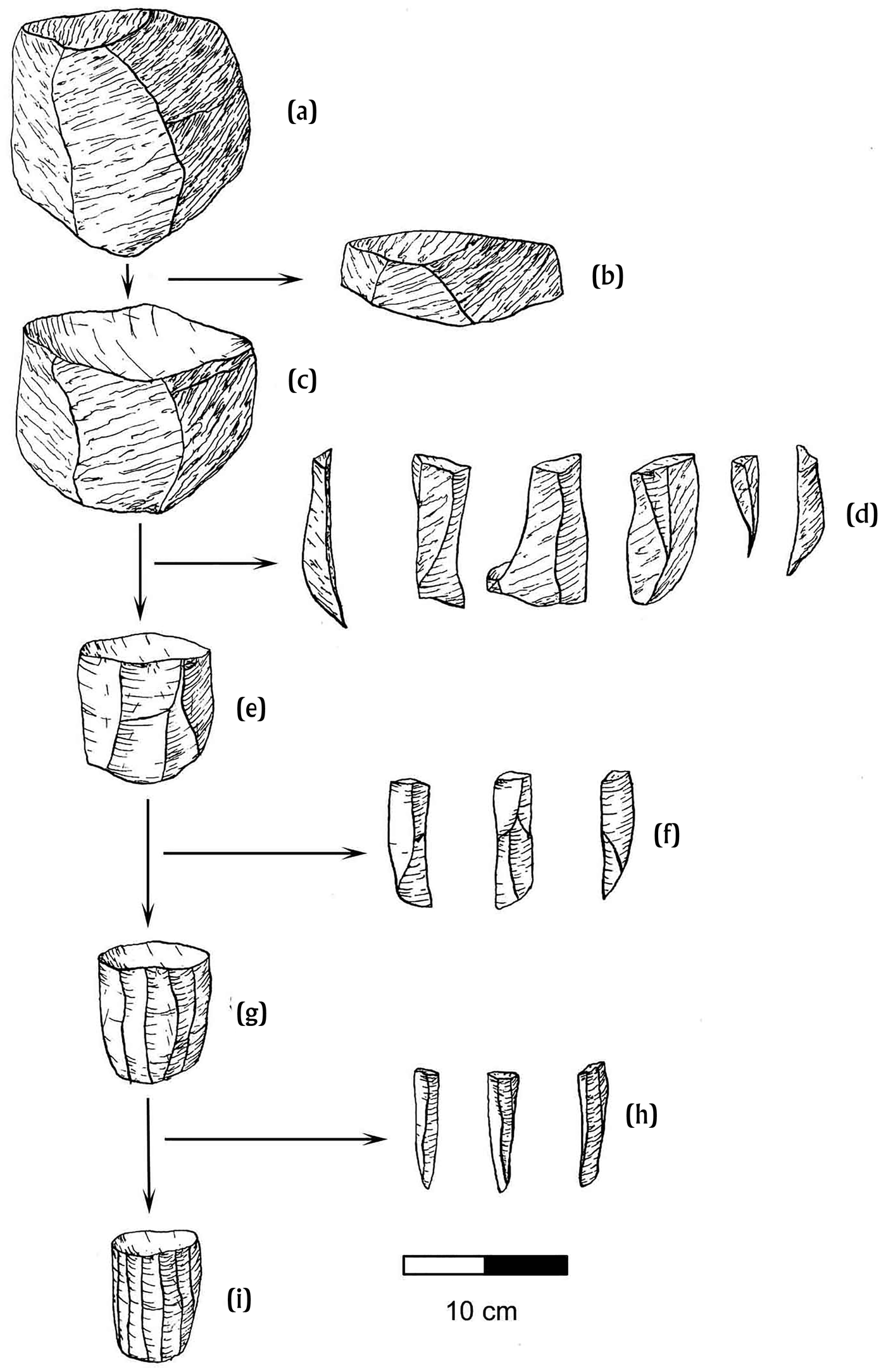
Figure 9. General blade-core reduction sequence, percussion-based: (a) raw material in block form; (b) platform preparation flake; (c) core preform; (d) decortication flakes and macroflakes; (e) primary macrocore; (f) macroblades; (g) secondary macrocore; (h) small percussion blades; (i) polyhedral core. Illustration by B. Andrews
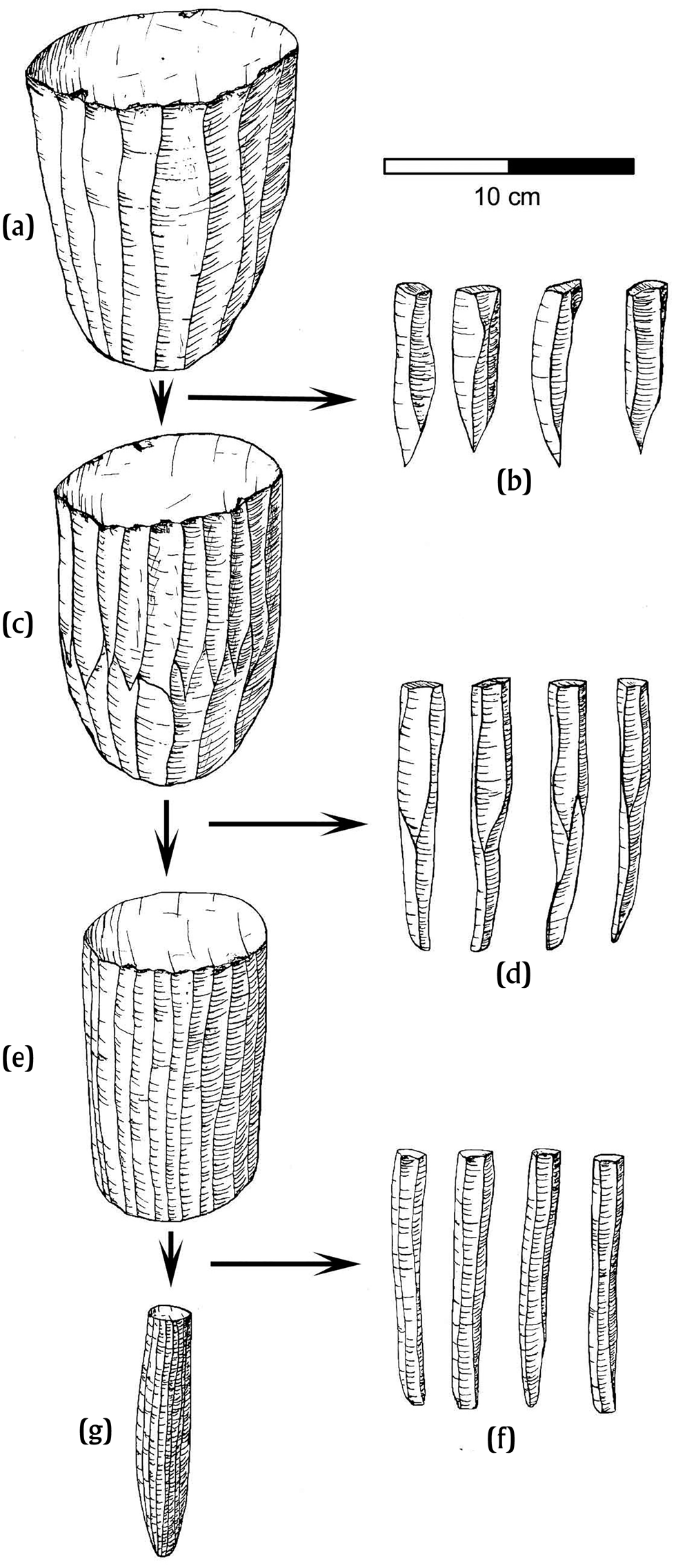
Figure 10. General blade-core reduction sequence, pressure-based: (a) polyhedral core; (b) first-series blades; (c) secondary polyhedral core; (d) second-series blades; (e) pressure core; (f) third-series blades; (g) exhausted core. Illustration by B. Andrews

Figure 11. Illustration of the artifacts associated with the process of blade-core platform rejuvenation: (a) core top; (b) core section; (c) core section flake; (d) platform preparation flakes; (e) distal orientation flake. Illustration by B. Andrews.
De León (Reference De León2008:162–166; De León et al. Reference De León, Hirth and Carballo2009:115) has divided the artifacts associated with the process of blade crafting into technologically diagnostic “primary” and “secondary” evidence of blade production (Table 10). “Primary evidence” comprises core artifacts that are by-products of the pressure-based sequence (Figure 12). These items include exhausted pressure cores, core rejuvenation artifacts, recycled cores, and core implements. These artifacts are considered primary because they represent direct evidence of prismatic blade production (i.e., blades are removed from these items). In contrast, “secondary evidence” includes macroflakes, macroblades, and small percussion blades removed during early core shaping (secondary evidence, percussion-derived), initial-series pressure blades, third-series blade removal errors (e.g., hinge fractured blades), error-recovery artifacts, and items such as snapped blade fragments (secondary evidence, pressure-derived, Figure 13). These artifacts are considered secondary because they represent indirect evidence of blade production (i.e., artifacts that are important procedural derivatives of the overall reduction process). Although all the artifacts associated with these categories indicate the production process, most of the larger artifacts could also be used or modified for use as tools; consequently, where they are found does not necessarily equate de facto with where blades were actually produced. That depends on their proportional frequencies and the nature of the archaeological context where they were recovered.
Table 10. Primary and secondary artifacts associated with the production of obsidian prismatic blades (De León Reference De León2008).
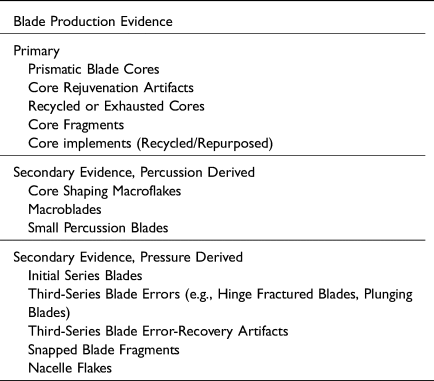

Figure 12. Illustration of primary indicators of blade production: (a–c) prismatic blade cores; (d) core-top; (e) core-section flake; (f) platform preparation flake; (g) recycled bipolared prismatic blade core; (h–i) bipolared blade core sections. Artifact proveniences: (a–e) Xochicalco; (f) Coatlan del Rio, (h–i) Calixtlahuaca. Illustrations by L. Gaviño Vidarte, B. Andrews, and L. Potwardowski.

Figure 13. Illustration of secondary indicators of blade production. Secondary evidence, percussion derived: (a) macroflake with cortex; (b) macroflake; (c) macroblade proximal section; (d) small percussion blade section; (e) distal small percussion blade, distal section (used as scraper). Secondary evidence, pressure derived: (f) initial series pressure blade; (g) blade proximal section with hinge termination; (h) plunging blade section; (i) nacelle flake. Artifact proveniences: (a, d, e, f) Calixtlahuaca; (b) Yautepec; (c, i) Coatlan del Rio; (g–h) Xochicalco. Illustrations by B. Andrews, C. Hart, and H. Bolz-Weber.
The household assemblages for the Dongu, Ninupi, and Yata phases (Table 11), have very little primary evidence of blade production (<0.7%). Some assemblages have slightly higher frequencies of secondary evidence (0–7.4%), but most of these artifacts are small percussion blades and macroblades. In other words, almost none of the secondary evidence relates to the pressure end of the production sequence (first-series and second-series pressure blades and by-products of third-series prismatic blade production). Such proportions are too low to support the suggestion that prismatic blades were made in any of these excavated households. Moreover, most of the small percussion blades and macroblades (ca 50–100% of them; Table 11) exhibit use wear, indicating that although they are blade production by-products, they were consumed as tools at Calixtlahuaca. Finally, the frequency of these production artifacts does not appear to differ significantly among the households, suggesting once again that stone tool use was similar throughout the city over time. What is clear is that the percentages of these production categories differ markedly from those tabulated for the documented blade workshops identified elsewhere in Mesoamerica (Table 9). These contexts have proportionally high percentages of primary and/or secondary blade production evidence, largely dependent on what form obsidian raw material entered the workshop. Based on De Leon’s (Reference De León, Hirth and Carballo2009) model and his interpretation of the published technological artifact categories, the tabulations of the primary and secondary comparative figures generated for Table 9 were compiled by the first author. In general, a high percentage of primary evidence typically indicates that raw material entered workshops as well processed cores ready for third-series blade production, whereas a high percentage of secondary evidence (especially secondary percussion artifacts) often indicates that raw material arrived in larger macrocore/polyhedral core form.
Table 11. Primary and secondary evidence for blade production according to household components over time (DS-1 and DS-2 samples).

a Fisher exact test indicates that 307 and 323 are significantly different (p <0.5) in terms of evidence for blade production. Unit 307 has comparatively few artifacts representing either category, whereas Unit 323 has a comparatively high percentage of secondary evidence.
b Fisher exact test indicates that 316 is significantly different (p <0.05) in terms of evidence for blade production. It has a comparatively high percentage of secondary evidence.
c Fisher exact test indicates that none of the unit distributions are significantly different in terms of evidence for blade production.
To summarize, the Calixtlahuaca household assemblages are comparatively small, have a few core artifacts (primary production evidence), a few percussion blades (secondary production artifacts), and very few initial pressure blade artifacts (removed just prior to third-series blade production). These characteristics are inconsistent with the shaping and reduction of macrocores/polyhedral cores and the production of third-series blades in the Calixtlahuaca households. Instead, it seems that households consumed third-series blades and, in a few cases, limited numbers of sturdier macroblades and small percussion blades. How did the Calixtlahuacans get these tools in the absence of any blade workshops?
Modeling blade provisioning for Calixtlahuaca
We argue that Calixtlahuaca was supplied with finished blades in a central market by merchant/craftsmen who visited the city periodically. Unfortunately, the location of such a market setting was not identified during the project, although it was probably somewhere at the foot of Cerro Tenismo (Figure 14). We wish to emphasize that many of the artifacts that qualify as primary and secondary evidence were also commodities well suited for activities that could not be accomplished with small, third-series prismatic blades (Parry Reference Parry1987). For example, intensive sawing and scraping of durable media such as hard wood or bone could more easily be accomplished with sturdier, more robust percussion blades (Walton Reference Walton2017). Exhausted cores could be fashioned into gouging and scraping implements, reduced for usable flakes with percussion and bipolar techniques (Boksenbaum Reference Boksenbaum1978) or recycled into beads (Andrews and Glascock Reference Andrews and Glascock2020; Andrews and Hirth Reference Andrews, Hirth and Hirth2006). Ethnohistoric sources describe items plied by the “obsidian seller” that probably represent some of these blade production artifacts. Clark (Reference Clark, Gaxiola G. and Clark1989:310) suggested that besides pressure blades, the obsidian seller described by Sahagún (Reference Sahagún, Anderson and Dibble1961) also traded macroblades and small percussion blades, “V-shaped” pieces, unifacial scrapers, and maguey scrapers in the market. The V-shaped pieces could refer to triangular blades, but they also could be artifacts such as core tops, core section flakes, and platform preparation flakes (Figure 11). If we conclude that blades were not made in the city, then what do the limited amounts of primary and secondary blade production artifacts indicate about how the city was provisioned with these items?

Figure 14. Artist's reconstruction of Postclassic Calixtlahuaca's marketplace. Illustration by Michael Stasinos.
De León and colleagues (Reference De León, Hirth and Carballo2009) modeled expectations for different Formative-period blade provisioning systems (Table 12). We acknowledge that life during the Formative period was very different than it was during the Postclassic period (complexity of economies, size of social systems, etc.), but the expectations are still useful for evaluating how blades were acquired by Calixtlahuacan consumers. The models we consider include (1) whole-blade trade, (2) processed-blade trade, (3) long-distance itinerant craftsmen, and (4) local, hinterland-based craftsmen. All models assume that market transactions would have taken place in a dedicated marketplace setting or door-to-door peddling (although other variations are possible, and some obsidian probably moved via nonmarket exchange).
Table 12. Differential expectations for blade provisioning at Calixtlahuaca (adapted from DeLeón et al. Reference De León, Hirth and Carballo2009)

a The blade section ratios here represent the average figures for the Dongu, Ninupi, and Yata Postclassic occupations of the city. See Table 13 for the figures for each time period.
Table 13. Gray and green blade section ratios from Calixtlahuaca households over time.

Besides the respective percentages of primary and secondary production artifacts, ratios of blade sections are also useful for evaluating these models, especially ratios of proximal to distal and medial to distal sections (Clark and Bryant Reference Clark and Bryant1997; De León et al. Reference De León, Hirth and Carballo2009; Ossa Reference Ossa2022; Walton Reference Walton2017). Blades were typically snapped into segments before use. All other things being equal, production of third-series blades should result in a proximal to distal ratio of 1:1 and a medial to distal ratio of 2–3:1, assuming that most blades were segmented into two or more medial sections. Depending on how blades got to consumers, these ratios can hypothetically vary (Table 12). We examine these ratios for gray and green obsidian separately to detect provisioning differences according to source. The expected blade section ratios for different provisioning systems are obviously ideals. For this reason, evaluating these lines of evidence together is imperative.
The models
Whole-blade trade
The whole-blade trade model assumes the trade of complete blades that were made elsewhere and brought to the venue of exchange as finished products, either by the producer or merchant middlemen (De León et al. Reference De León, Hirth and Carballo2009:115) (Table 12). Accordingly, there should be no primary or secondary production evidence (like you would find at a workshop); there should be, however, a proximal to distal section ratio of 1:1 and a medial to distal section ratio of 2–3:1. But, because some cores yield curved blades, especially at their distal ends, these typically fragile distal sections were sometimes removed to facilitate transport (De León et al. Reference De León, Hirth and Carballo2009:116–117). This practice could, therefore, increase the ratios of proximal and medial sections to their distal counterparts.
Processed-blade trade
This model posits that blades were produced elsewhere and then snapped into sections before transport and brought to the venue of exchange as segments by the producer or a merchant middleman (De León et al. Reference De León, Hirth and Carballo2009:118). Like the whole-blade trade model, there should be no primary and secondary production evidence, but the proximal to distal and medial to distal ratios could be as high as 6:1 (Table 12). Like the whole-blade trade model, a proximal to distal ratio of 6:1 also assumes that most distal sections were not transported for exchange. However, this ratio could be lower if many proximal sections were also not traded (they are typically thicker at the bulb bearing end—not standardized in terms of overall dimensions like medial sections). What needs to be stressed, therefore, is that the proximal to distal and medial to distal ratios need to be considered in tandem.
Long-distance itinerant craftsmen
This model refers to those who traveled from market to market making blades at a centralized on-site location, periodically acquiring raw material during their rounds at quarries and/or from craft workshops near quarries. Hirth (Reference Hirth2008) has proposed a similar model for Epiclassic Xochicalco, although it is distinct in that long-distance itinerant craftsmen supplied partially reduced cores for Xochicalco's pressure blade workshops, in addition to larger blades to the general populace in its central market. In this scenario, Calixtlahuaca would have been but one attractive stop along the way because its size represented a relatively large pool of constant demand, and its location was geographically strategic. Although Calixtlahuaca was outside the Basin of Mexico, it was only 50 km distant, making it a relatively accessible venue for Basin-based itinerant craftsmen. It was also located along the route from west Mexico to various locations in central Mexico. That such a route was well traveled is partially supported by the fact that a significant percentage of the city's obsidian is from the west Mexican source of Ucareo (Figure 1).
This model would be evinced by a lack of primary evidence for blade production, presumably because these roving merchant/craftsmen would have retained cores during their travels. However, secondary evidence for blade production could be present, especially the larger percussion flakes and blades, which, as mentioned above, we know were obsidian products available in the market (Clark Reference Clark, Gaxiola G. and Clark1989). Similar to the whole-blade trade model, this model should be associated with a proximal to distal ratio of 1:1 and medial to distal ratio of 2–3:1.
Local, hinterland-based craftsmen
This model refers to blade provisioning by “rural” craftsmen residing in Calixtlahuaca's hinterland. As discussed above, rural blade-crafting contexts dating to the Postclassic period have been documented in west Mexico (Darras Reference Darras2009) and Tlaxcala (Gentil et al. Reference Gentil, Castellanos and Hirth2021). This model represents what has been called intermediate-level scale exchange, which moved many goods no more than 20 to 30 km; such traders were extremely important in ancient Mesoamerica for economically integrating local and regional systems (Berdan Reference Berdan2014; Hirth Reference Hirth, Hirth and Pillsbury2013:97–99).
This short-distance model could have worked two ways: (a) core shaping in hinterland-based workshops followed by periodic forays to Calixtlahuaca to reduce pressure cores in the market; or (b) core shaping in hinterland workshops, production of third-series blades, then periodic forays to Calixtlahuaca to trade finished blades. Relative to the long-distance itinerant merchant, it would have been less onerous for locally based craftsmen to bring some heavier percussion blades as well as third-series blades to Calixtlahuaca for exchange. Accordingly, this model posits the presence of both primary and secondary blade production evidence (Table 12), and because production is essentially local, a proximal to distal ratio of 1:1 and medial to distal ratio of 2–3:1.
Evaluating the models
Whole-blade trade
This model seems least likely given the expectations. Only a single complete blade was recovered during the project (Figure 4c); the rest are blade segments. Although limited, the Calixtlahuacan components do have both primary and secondary blade production artifacts (Table 11), traits that are incompatible with this model senso stricto (Table 12). Looking at the blade section ratios, the proximal to distal ratios for both gray and green fit the expectations reasonably well, but the medial to distal section ratios are much higher than would be expected (Table 13). Finally, conjectural as it may be, the claim has been made that whole-blade trade was largely out of vogue by the end of the Formative period (Clark Reference Clark, Johnson and Morrow1987). Whatever the case, we do not think that these lines of data in concert convincingly support this model.
Processed-blade trade
Like the whole-blade trade model, the expectations for the processed-blade trade model are also contradicted by the presence of both blade production categories (Table 12). However, the blade section ratios, especially the gray material, do provide some support for this model. The proximal to distal ratios do not fit the expectations unless traders were bringing primarily medial sections to the market. As suggested above, a processed-blade trade system might primarily supply medial sections because of their standardized dimensions, making them “ready-made for consumption” and/or easy to pack for overland transport. The consistently high ratios of gray medial to distal sections would be consistent with this notion. Moreover, it is apparent that the gray medial to distal section ratios increase over time, indicating that processed-blade trade became most important in the Yata phase. The green medial to distal section ratios are also higher than the proximal to distal ratios, but this disparity is not as great, and the medial to distal section ratio actually decreases over time (Table 13). Consequently, based on these data, it seems less likely that the green obsidian was provisioned with a processed-blade trade system.
Long-distance itinerant craftsmen
In this model, the presence of primary production evidence does not fit the expectations, but the presence of secondary evidence does (Table 12). In terms of blade sections, the ratios of gray proximal to distal sections fit the expectations, but the medial to distal section ratios are too high; this disparity is not what one would expect if blades were made in the market by traveling craftsmen for exchange at Calixtlahuaca. The green blade section ratios, however, do fit the expectations reasonably well, especially for the Yata phase (Table 13). If this was the case, it would be consistent overall with the notion that by the Yata phase, Calixtlahuaca was heavily tied into commercial networks coming out of the Basin of Mexico (Huster Reference Huster2016). Green obsidian becomes the most prevalent at Calixtlahuaca by this time, and ethnohistoric data suggest that traveling merchant/craftsmen did supply Late Postclassic consumers with blades and other obsidian tools (Clark Reference Clark, Gaxiola G. and Clark1989; Sahagún Reference Sahagún, Anderson and Dibble1961). We suggest that some of these merchant/craftsmen probably made their rounds, at least in part, in the nearby Toluca Valley.
Local, hinterland-based craftsmen
This model fits the expectations in that it has both primary and secondary evidence of blade production (Table 12). However, like the long-distance itinerant model, the gray blade section ratios do not fit this model, but the green blade sections do (Table 13). Consequently, at least for green obsidian, one might conclude that the short-distance craftsmen model is the best fit as the expectations are modeled. There are at least two reasons to suggest otherwise. First, as stated, this model assumes the presence of blade-core workshops in Calixtlahuaca's hinterland. Archaeological research on the Postclassic Toluca Valley has been limited, and to our knowledge there is no evidence of a blade workshop in the Toluca Valley, either during the Postclassic period or earlier. Second, most of Calixtlahuaca's blades are made from obsidian sources located 150 and 170 km away. Consequently, it seems unlikely that it would have been carried such distances as heavy macrocores or polyhedral cores, whose initial reduction would account for the limited secondary blade production evidence in the city. Benitez (Reference Benitez2006:88) reports two possible obsidian sources rumored to be somewhere in the northern Toluca Valley, but they never have been definitively located. Also, there is no reported evidence for an unknown obsidian source of consequential frequency for any sites in the area. Even though these sources may in fact exist, at present, it seems doubtful that they were heavily quarried for stone during the pre-Hispanic period.
Considering the expectations associated with these models, we suggest that the primary and secondary blade production evidence need not be conceptualized as strictly presence/absence. Indeed, the percentages of both of these artifact categories are extremely low at Calixtlahuaca. Because of this, the more difficult question to answer is how low they need to be to accept or reject a given model. More to the point, is this the question we should even be asking? To be sure, not only do the artifacts associated with these categories inform us about the process of blade production, but they also can be used as tools for a variety of activities. Indeed, most of this evidence in the Calixtlahuaca household components is predominantly percussion blades; out of a total of 145 secondary production artifacts over all three phases, fully 83% (N = 120) were macroblades and small percussion blade segments (see Figure 9), most with macroscopic use wear. Finding limited amounts of blade production evidence in a settlement largely provisioned with stone tools in the market, therefore, should be no surprise. From this analysis, therefore, we have concluded that much of the gray obsidian probably came to the city via a system of processed-blade trade. In contrast, much of the green, Pachuca obsidian probably came to the city via long-distance itinerant merchant/craftsmen coming out of the Basin of Mexico.
Conclusions
The Calixtlahuaca Project recovered a subsurface data set from extensive excavations that are securely dated to the Dongu (a.d. 1130–1380), the Ninupi (a.d. 1380–1450), and the Yata phases (a.d. 1450–1530). Based on the technological analysis of its lithic artifacts, it is clear that the city's households consumed tools made with blade-core, biface, and bipolar technologies (Tables 5–7). Most of these artifacts are obsidian (95%; Table 1), sourced to Ucareo in west Mexico, and to Pachuca and Otumba in central Mexico (Figure 3). It seems that the Calixtlahuacans were largely consumers of stone tools. Although there is evidence for the shaping and maintenance of biface/uniface artifacts and the use of bipolar techniques to “rejuvenate” used obsidian tools in the households, it does not appear that the city had any prismatic blade workshops.
The contextual and technological characteristics of the Calixtlahuaca household assemblages are not consistent with blade production. Production contexts generate immense amounts of debitage (Table 9); the Calixtlahuaca household assemblages are comparatively small. Following De León (Reference De León, Hirth and Carballo2009), we evaluated the frequencies of what he calls primary production artifacts (core artifacts) and secondary production artifacts (items removed from cores during the process of making blades, which includes macroflakes, percussion blades, etc.). These categories are present at Calixtlahuaca, but their frequencies are extremely low compared to those for known blade workshops (Tables 9 and 11). Based in part on ethnohistoric evidence (Clark Reference Clark, Gaxiola G. and Clark1989), these artifacts were more likely disseminated by merchant/craftsmen in the market along with prismatic blades. To reiterate, finding them in the Calixtlahuaca households does not unequivocally mean that blades were made in these settings; there was a market demand for the larger, more robust percussion derivatives for activities that could not be effectively accomplished with more delicate third-series prismatic blades.
Lacking evidence of on-site blade workshops, we evaluated four models for explaining how blades and related artifacts may have made it to the city: (1) whole-blade trade, (2) processed-blade trade, (3) long-distance itinerant craftsmen, and (4) local, hinterland-based craftsmen residing in Calixtlahuaca's hinterland (Tables 12 and 13). Assuming that a low frequency of blade production artifacts does not equate with on-site blade production, our analysis most strongly favors a processed-blade trade provisioning system (exchange of segmented blade sections) for much of the gray obsidian (Table 12). Although sourcing analysis indicates that a few blades were made of Otumba obsidian, most of the gray blade-core material is from west Mexico.
In contrast, the green obsidian coming from Pachuca best fits the itinerant long-distance craftsmen model (Table 12). It is possible that green obsidian was supplied by craftsmen living in Calixtlahuaca's hinterland, but until we have more comprehensive survey data on Postclassic settlements in the Toluca Valley, it seems more parsimonious to assume an absence of nearby blade workshops. The presence of two distinct supply patterns is consistent with the findings of a recent analysis of Postclassic exchange networks suggesting that west Mexican obsidian moved in a largely separate network from the central Mexican sources (Golitko and Feinman Reference Golitko and Feinman2015). Calixtlahuaca—and the Toluca Valley more broadly—would be a logical geographic and cultural zone of overlap between these two regions. The consequence was competition, which merchants drawing on the west Mexican sources apparently started to lose. Calixtlahuaca did not have resident blade craftsmen, so the citizens probably obtained blades via market exchange. Indeed, probable blade trade provisioning has also been inferred for the Postclassic sites of Cihuatecpan (Walton Reference Walton2017) and Xaltocan (Millhauser Reference Millhauser and Brumfiel2005), and most recently, for the polity of Sauce in Veracruz (Ossa Reference Ossa2022). Based on our study, we suggest that other sites without workshop contexts (e.g., Xico) may also have been provisioned in this way.
Borejsza and colleagues (Reference Borejsza, Rodríguez, Fredrick and Smith2021) have made a strong case that the Calixtlahuacans invested in their terracing system and surrounding outfields as a means of specializing in agricultural production. Although the Toluca Valley is relatively high in elevation (ca. 2,600 m), it gets ample summer precipitation—so much so that some Calixtlahuacans invested in their terracing system and surrounding outfields as a means of maximizing agricultural outputs, perhaps at the expense of other economic activities. This inference is also supported by the fact that little evidence of specialization in anything else—craft or otherwise—has been found in the city. Moreover, the same basic range of flaked stone tool technologies were used in the Calixtlahuacan households, regardless of time period, which further supports this proposition.
The Postclassic Mesoamerican World System was characterized by expanding trade and stylistic interactions among regions (Smith and Berdan Reference Smith and Berdan2003). Indeed, evidence from the Calixtlahuaca Project indicates that during the Ninupi phase (Late Postclassic A, a.d. 1380–1450), the city was well integrated into the exchange networks moving goods around Mesoamerica (Huster Reference Huster2016). Perhaps the central Mexican commercial system was so effective that urban centers like Calixtlahuaca could count on being provisioned with obsidian tools in the market. The city's inhabitants, however, had to take what they could get. Obsidian was not scarce at Calixtlahuaca, but it was restricted in that most of the lithic artifacts recovered in the city are relatively small. This would also seem consistent with systems of obsidian provisioning that brought finished implements from relatively distant sources. It also is consistent with the fact that the Calixtlahuacans used bipolar technology to rejuvenate their lithic artifacts. However much they became dependent on the market for their tools, by the time the city became a part of the Triple Alliance, the amount of obsidian its inhabitants had access to dropped by almost half compared to the previous period (Table 8). Undoubtedly, this change must have made life more challenging.
We suggest three directions for future research relating to this study. First, we need to evaluate how much of an impact the decline in obsidian during the Yata phase had on the technologies used by individual households, and whether households were supplied by different networks, specifically those coming from the Basin of Mexico versus those anchored in west Mexico. Second, a more systematic study of use wear should be conducted to ascertain whether stone tool consumption at Calixtlahuaca is consistent with the proposition that that economic activity at the site was primarily agricultural. A use-wear study might also reveal kinds of products the Calixtlahuacans specialized in producing. These two directions can be explored with the present data set. Third, further survey and excavation in Calixtlahuaca's hinterland would round out our knowledge of how the city articulated with outlying communities in various ways, including whether any of them had resident blade crafting specialists. As we have concluded, at this point, we think this is unlikely.
Further research on Postclassic stone tool economies may establish that, with some exceptions, most obsidian tool crafting in central Mexico took place relatively close to the sources. This provides some basis for understanding the variability in the location of blade crafting contexts across the Postclassic landscape—in particular, why some Aztec-period urban centers do not have workshops. Being able to count on a steady supply of obsidian, these cities could opt (or else they were left with little recourse) to specialize in the production of other resources, especially those most optimally suited to their local conditions. It seems that this strategy may have become an imperative given the previously degraded landscapes many of them had to adapt to in the face of rising central Mexican demographic pressure (Borejsza et al. Reference Borejsza, Rodríguez, Fredrick and Smith2021:255). Thus far, the Calixtlahuaca data set has proved invaluable for examining these questions, especially the comparative importance of exploring what life was like in a provincial Postclassic central Mexican setting.
Acknowledgments
The research presented in this paper was supported by NSF grants awarded to Smith for fieldwork (Urbanization and Empire at the Aztec-Period site of Calixtlahuaca, Award #0618462) and analysis (The Urban Economy of Aztec-Period Calixtlahuaca, Award #0924655), and an NSF Dissertation Improvement Grant awarded to Huster (Effects of Aztec Conquest on Provincial Commoner Households at Calixtlahuaca, Mexico, Award #1205738). We would also like to acknowledge an appreciation for the insights of Kenneth Hirth and Jason De Leon. Thanks also to other project members, especially Alex Borejsza, Juliana Novic, all the skilled and dedicated lab workers from Calixtlahuaca, and the support of the Colegio Mexiquense. Special thanks to Harper Bolz-Weber, Luis Gaviño Vidarte, Kipp Godfrey, Cheyenne Hart, Kathryn Hunt, Lina Potwardowski and Michael Stasinos for the wonderful illustrations. Finally, we appreciate the insightful comments provided by four anonymous reviewers.






























